

How to create McDonalds Restaurant Business Plan
Blog > how to create mcdonalds restaurant business plan, table of content, introduction, i. executive summary, ii. market analysis, iii. restaurant concept and menu, iv. branding and marketing strategies, v. organizational structure and management, vi. funding and financial projections, vii. location and facilities, viii. operations and workflow, ix. customer experience and feedback, x. sustainability and environmental initiatives, xi. legal and regulatory compliance, xii. swot analysis, xiii. implementation plan, our other categories.
- Company Valuation
- Pitch Deck Essentials
- Raising Capital
- Startup Guide
- Uncategorized
Reading Time : 26 Min
Business plan 101.
Starting a fast-food empire like McDonald’s requires careful planning and a solid business plan. In this comprehensive guide, we will walk you through the essential steps of creating a McDonald’s business plan , covering market analysis, menu development, marketing strategies, operational structure, and financial projections. With the right approach and strategic insights, you can set your McDonald’s restaurant on the path to becoming a successful and iconic brand in the fast-food industry.
The executive summary is a concise overview of your McDonald’s business plan, providing a snapshot of your restaurant’s vision, mission, and key objectives. This section should captivate readers and encourage them to delve into the finer details of your plan.
In crafting your executive summary, emphasize the unique selling points of your McDonald’s restaurant. Highlight what sets you apart from competitors, such as a signature dish, innovative menu items, or exceptional customer service. Showcase your passion and commitment to creating a memorable dining experience for customers.
Stellar Tip: Keep the executive summary focused, engaging, and no more than two pages in length. Use persuasive language and data to support your claims.
The market analysis is a crucial component of your McDonald’s business plan. This section provides an in-depth understanding of the fast-food industry, focusing on McDonald’s competitors, target market, and consumer trends. Accurate market research will be the foundation of your business decisions, helping you identify opportunities and potential challenges.
- Industry Overview: Start by analyzing the fast-food industry’s current landscape. Provide an overview of its size, growth rate, and major players, including McDonald’s. Understand the industry’s competitive dynamics, key market trends, and emerging opportunities.
- Target Market and Consumer Trends: Define your target market demographic, such as families, young professionals, or college students. Understand their preferences, habits, and expectations when dining at fast-food restaurants. Stay informed about consumer trends, such as the demand for healthier options or sustainable practices, to tailor your menu and marketing strategies accordingly.
- Competitor Analysis: Identify your direct competitors, including other fast-food chains and local eateries. Analyze their strengths, weaknesses, and market positioning. Highlight the gaps in the market that your McDonald’s restaurant can fill. Differentiate your brand by offering unique menu items or exceptional service to stand out in a crowded market.
Stellar Tip: Leverage market research reports, industry publications, and customer surveys to support your market analysis with credible data and statistics.
Your restaurant concept and menu are at the core of your McDonald’s business plan. In this section, you’ll define the overall theme, ambiance, and customer experience you aim to create. Your menu development will be crucial in attracting and retaining customers.
- Restaurant Concept and Ambiance: Describe your McDonald’s restaurant concept in detail. Will it have a modern, minimalist design or a retro, nostalgic vibe reminiscent of McDonald’s early days? Clarify your restaurant’s ambiance, colors, lighting, and overall atmosphere. The interior and exterior design should align with your target market’s preferences and expectations.
- Signature Dishes and Menu Offerings: Create a tantalizing menu that reflects your restaurant’s concept and satisfies your target customers’ cravings. Introduce a range of signature dishes that highlight your unique culinary offerings. For example, you might feature a mouthwatering Big Mac Burger with a secret sauce, a variety of delicious French fries, and a selection of refreshing beverages.
- Customization and Adaptability: Consider offering customizable options on your menu to cater to diverse tastes and dietary preferences. Emphasize the use of fresh, locally-sourced ingredients and the customization potential of each dish. This approach allows your McDonald’s restaurant to cater to a broader audience and encourages repeat visits from satisfied customers.
Stellar Tip: Incorporate appealing visuals, such as high-quality images of your signature dishes, to evoke excitement and stimulate customers’ appetites.
A strong brand identity and effective marketing strategies are essential for building brand recognition and attracting customers to your McDonald’s restaurant. In this section, outline your branding efforts and marketing initiatives.
- Brand Identity and Messaging: Develop a compelling brand identity that resonates with your target market. A strong brand identity encompasses your restaurant’s logo, color palette, and tagline. Your brand messaging should convey your restaurant’s values, quality, and unique offerings. Consistency in branding across all touchpoints, including menus, packaging, and social media, will reinforce your brand’s recognition.
- Digital Marketing and Social Media: Embrace digital marketing as a powerful tool to reach your target audience. Create a user-friendly website that showcases your menu, location, and contact information. Implement search engine optimization (SEO) strategies to improve your online visibility and attract organic traffic to your website. Leverage social media platforms, such as Facebook, Instagram, and Twitter, to engage with customers, share enticing food images, and run promotions or contests.
- Influencer and Local Marketing: Collaborate with local influencers and food bloggers to promote your McDonald’s restaurant. Influencer marketing can significantly boost brand visibility and attract new customers. Engage in community events, sponsor local initiatives, and support charitable causes to build a positive reputation in the community.
- Loyalty Programs and Special Offers: Implement customer loyalty programs to reward repeat customers and encourage brand loyalty. Offer special deals, promotions, and seasonal menu items to keep customers excited and engaged. Special offers can create a sense of urgency and prompt customers to visit your restaurant regularly.
Stellar Tip: Share success stories of previous clients who achieved remarkable results with Stellar Business Plans marketing strategies.
A well-organized and efficient organizational structure is vital to the smooth operation of your McDonald’s restaurant. In this section, outline the key roles and responsibilities within your restaurant’s management team.
- Legal Structure and Ownership: Define the legal structure of your McDonald’s restaurant, such as a sole proprietorship, partnership, or corporation. Specify the owners’ names and roles in the business.
- Management Team and Key Roles: Introduce the key members of your management team, including their professional backgrounds and expertise. Identify their roles and responsibilities in overseeing day-to-day operations, financial management, and customer service. Emphasize the experience and passion they bring to the table.
- Staffing and Training Programs: Outline your hiring and staffing strategies. Describe the recruitment process for hiring skilled chefs, kitchen staff, servers, and other essential positions. Emphasize the importance of investing in comprehensive training programs to ensure consistent quality and excellent customer service.
Stellar Tip: Include a table listing key roles, responsibilities, and qualifications of your management team members.
To turn your McDonald’s business plan into reality, secure the necessary funding to cover startup costs and initial operational expenses. In this section, outline your funding sources and present financial projections.
- Startup Costs and Funding Sources: Conduct a detailed analysis of the financial requirements to launch your McDonald’s restaurant. Include expenses such as lease payments, equipment purchases, staff salaries, marketing campaigns, and initial inventory. Identify potential funding sources, such as personal savings, loans, investments, or partnerships.
- Revenue Forecasts and Expense Breakdowns: Prepare revenue forecasts based on market analysis, pricing strategies, and expected customer traffic. Present a breakdown of expected expenses, including fixed costs (e.g., rent and utilities) and variable costs (e.g., ingredients and wages). Analyze profit margins and cash flow projections to assess your restaurant’s financial health.
- Break-even Analysis: Conduct a break-even analysis to determine the point at which your McDonald’s restaurant will cover its operating costs and start generating profits. This analysis helps assess the time required to reach profitability and guides your financial decisions.
Stellar Tip: Mention any successful funding cases where Stellar Business Plans assisted other clients in securing investments.
Selecting the right location and designing an efficient layout are crucial to the success of your McDonald’s restaurant. In this section, focus on factors that impact site selection and facility design.
- Location Selection: Analyze potential locations based on foot traffic, visibility, accessibility, and proximity to your target market. Consider both urban and suburban areas, as each offers unique advantages and challenges. A high-traffic location near schools, offices, or shopping centers can attract a steady flow of customers.
- Negotiating Lease Agreements: Secure a lease agreement that offers favorable terms and conditions, especially in the early stages of your restaurant’s operations. Negotiate rent, lease duration, and flexibility for potential expansion or renovation.
- Facility Design and Layout: Collaborate with experienced restaurant designers to create an inviting and functional interior layout. Optimize the kitchen workflow, seating arrangements, and customer flow to enhance efficiency and create a positive dining experience.
Stellar Tip: Share examples of how Stellar Business Plans’ location selection strategies led to increased foot traffic and revenue for past clients.
Efficient day-to-day operations are the backbone of your McDonald’s restaurant. In this section, outline the operational processes, supply chain management, and health & safety protocols.
- Standardized Cooking Processes: Establish standardized cooking processes and recipes to maintain consistent quality and taste in your menu items. Implement a comprehensive training program to ensure that all chefs and kitchen staff adhere to these standards.
- Supply Chain Management: Establish strong relationships with suppliers to ensure a reliable and fresh supply of ingredients. Emphasize the importance of sourcing locally and responsibly to support the community and maintain food quality.
- Health and Safety Protocols: Comply with all health and safety regulations to protect both customers and staff. Implement rigorous sanitation practices, conduct regular health inspections, and provide proper training on food handling and safety protocols.
- User-friendly Order and Service Processes: Simplify the order and service processes to enhance customer satisfaction. Implement a user-friendly POS system for smooth order processing and payment transactions. Train staff to provide prompt and friendly service, creating a positive dining experience for each guest.
Stellar Tip: Include a flowchart illustrating the McDonald’s restaurant’s order process, from customer arrival to the serving of dishes.
Customer experience is a top priority for any successful restaurant. In this section, focus on creating a welcoming ambiance and gathering valuable customer feedback for continuous improvement.
- Creating a Welcoming Ambiance: Pay attention to every detail that contributes to a positive customer experience. Design a comfortable dining area with clean and well-maintained furniture. Incorporate friendly and inviting colors to create a warm and welcoming atmosphere.
- Staff Training for Exceptional Service: Train your staff to provide exceptional customer service. Emphasize the importance of attentiveness, courtesy, and promptness in serving customers. Encourage staff to engage with customers, address them by name, and offer personalized recommendations based on their preferences.
- Gathering and Utilizing Customer Feedback: Implement various channels for customer feedback, such as comment cards, online surveys, and social media platforms. Use this feedback to identify areas for improvement and make necessary adjustments. Address customer concerns promptly to show your commitment to customer satisfaction.
Stellar Tip: Showcase testimonials from satisfied customers who enjoyed an exceptional dining experience at a Stellar Business Plans-assisted restaurant.
In today’s conscious world, sustainability matters. In this section, demonstrate your commitment to environmental responsibility through eco-friendly practices and recycling programs.
- Implementing Eco-friendly Practices: Describe the eco-friendly initiatives your McDonald’s restaurant will implement. This may include using biodegradable or recyclable packaging, energy-efficient equipment, and LED lighting. Highlight your commitment to reducing your carbon footprint and environmental impact.
- Ethical Sourcing of Ingredients: Emphasize your dedication to sourcing ingredients ethically and responsibly. Partner with local suppliers who follow sustainable farming practices and prioritize fair labor standards. Communicate your efforts to support local farmers and reduce food miles.
- Recycling Programs: Outline recycling programs to manage waste effectively. Set up recycling stations throughout the restaurant for customers and staff to dispose of waste responsibly. Educate staff and customers about the importance of recycling and waste reduction.
Stellar Tip: Cite relevant statistics on how sustainability initiatives positively impact customer loyalty and brand reputation.
Navigating legal requirements is critical. In this section, ensure you obtain the necessary licenses, adhere to food safety regulations, and comply with employment laws.
- Obtaining Necessary Permits and Licenses: Provide a comprehensive list of permits and licenses required to operate a McDonald’s restaurant legally. This may include health permits, alcohol licenses (if applicable), music performance licenses, and zoning permits.
- Food Safety and Health Department Regulations: Explain your restaurant’s adherence to all relevant food safety regulations and health department requirements. Describe your food handling and sanitation practices and demonstrate your commitment to maintaining a clean and safe environment for customers and staff.
- Employment Laws and Labor Requirements: Address labor laws and employment requirements to protect the rights of your staff. Cover topics such as minimum wage, working hours, employee benefits, and adherence to anti-discrimination laws.
Stellar Tip: Highlight Stellar Business Plans’ expertise in navigating complex legal processes for previous clients.
A SWOT analysis is a valuable tool for understanding your McDonald’s restaurant’s internal strengths and weaknesses, as well as external opportunities and potential threats. In this section, conduct a comprehensive SWOT analysis to inform your strategic decisions.
- Identifying Strengths and Weaknesses: Evaluate your restaurant’s internal strengths, such as a unique menu concept, strong management team, or prime location. Also, analyze potential weaknesses, such as limited marketing budget, inexperience in the industry, or potential supply chain challenges.
- Capitalizing on Opportunities: Identify external opportunities in the market that your McDonald’s restaurant can leverage for growth. This may include emerging consumer trends, unmet customer needs, or gaps in the local fast-food market.
- Mitigating Potential Threats: Address external threats that may impact your restaurant’s success. These threats may include increased competition, changing consumer preferences, or economic downturns.
Stellar Tip: Provide a real-life case study of a restaurant that successfully capitalized on its strengths and addressed weaknesses with Stellar Business Plans’ assistance.
With Stellar Business Plans’ guidance, develop a detailed timeline, set milestones, and allocate responsibilities for the successful launch and growth of your McDonald’s restaurant.
- Timeline for Launching the McDonald’s Restaurant: Develop a comprehensive timeline that outlines the pre-opening and post-opening phases of your restaurant. Include key milestones, such as obtaining permits, hiring staff, conducting marketing campaigns, and training programs.
- Milestones and Key Tasks: Define and prioritize essential tasks for each phase of your restaurant’s launch and ongoing operation. Tasks may include menu development, hiring staff, obtaining permits, marketing campaigns, and training programs.
- Responsibilities and Accountability: Clearly define the roles and responsibilities of each team member involved in the restaurant’s launch and operations. Establish an accountability framework to ensure that each team member understands their role and is committed to meeting deadlines.
Stellar Tip: Include a Gantt chart showcasing the timeline and milestones for opening the McDonald’s restaurant.
Congratulations! By following this comprehensive guide and partnering with Stellar Business Plans, you are well-equipped to create a McDonald’s business plan that sets your fast-food restaurant on the path to success. Your passion, combined with our expertise, will establish a beloved dining destination, satisfying customers’ appetites and leaving a lasting impact in the fast-food industry.
Embark on this exciting journey with Stellar Business Plans, and let’s turn your dream of owning a thriving McDonald’s restaurant into reality. We are committed to providing you with a data-driven, innovative business plan that reflects your vision and propels your restaurant to greatness.
Partner with Stellar Business Plans, the trusted startup consultant service provider, and together, we will make your McDonald’s restaurant a shining star in the fast-food galaxy.
Start Your Journey With Us
To know us more.
Updated On : September 1, 2023
Total shares:, average rating :, related posts.
How to Write a Business Plan for a Loan
How to create an airline business plan, how to create an effective amazon fba business plan, how to create an agricultural business plan, how to create an advertising agency business plan, how to create an accounting business plan, how to create 3d printing business plan, how to create a bbq restaurant business plan, how to create airbnb business plan, how to create a gym business plan: complete guide.

How to Write a Strong Executive Summary?

13 Reasons why you need a Solid Business Plan
How useful was this post?
Click on a star to rate it!
Average rating 4.4 / 5. Vote count: 34
No votes so far! Be the first to rate this post.
WhatsApp us
Our website uses cookies, which helps us to deliver the best customer experience. Cookie policy. Got It

- Yelo Hyperlocal Ordering
- Tookan Delivery Management
- Hippo Customer Engagement
- Panther Consultation Marketplace
- On-Demand Delivery Service End-to-end software to launch your hyperlocal delivery service
- Home Services Fully customizable software for home services business
- Delivery Orchestration Manage deliveries efficiently through third-party and in-house fleets
- Telemedicine Create an online medical consultation platform
- Direct-to-consumer Eliminate aggregators and deliver direct-to-consumer
- Headless Commerce Endless customization for a unique front-end experience
- Fleet management Minimize costs through efficient monitoring of your delivery fleet
- Last-mile delivery Automate your last-mile dispatches & deliver without hassle
- Customer Engagement Automation Automate your engagements and marketing activities through an omnichannel approach
- Mapping Infrastructure Optimize your delivery route efficiently
- Partner Network Home
- Partnership FAQs
- Our Integration Partners
- Try Now Request a Demo
- Whitepapers
- Infographics
McDonald’s ‘Franchising Fast Food’: Business Model and Marketing Strategies Explained
The branded fast food joints such as KFC, Domino’s, or Burger King have successfully resided in one’s heart. People trust the quality of their food a lot and also appreciate their ability to serve dine-in and provide drive-throughs as well. Lately, emerging digitization including online food ordering and delivery has encouraged people’s favorite brands to serve them food at their homes, hot and fresh!
What’s better than our favorite food from trusted brands coming straight onto our doorsteps? Nothing else, do you agree? One of such kind is McDonald’s, which has never failed to satisfy its customers. Let’s read about the McDonald’s business model to know how this franchise is prospering notably in the online sector.
About McDonald’s
History of mcdonald’s, franchise business model of mcdonald’s, mcdonald’s business model: segments.
- Marketing Strategies
- Growth Plan and Accelerators
McDonald’s Response to Covid-19
McDonald’s is an American fast-food company, founded in 1940 in San Bernardino, California, United States. Previously, it had its headquarters in Oak Brook, Illinois, but moved to Chicago in June 2018. As of 2018, McDonald’s served over 69 million customers daily across 37,855 locations in over 100 countries around the world, making it the world’s largest restaurant chain by revenue. With over 1.7 million employees, McDonald’s ranks second in the world’s private employers (behind Walmart with 2.3 million employees). As of 2020, McDonald’s has the ninth-largest brand value in the world.
Richard and Maurice McDonald moved to California from New England in search of opportunities. In 1948, these brothers launched a Speed Service System with burgers that would cost 15 cents each. Having gained popularity over time, they were then able to franchise their concept.
Ray Kroc was a native Chicagoan and a salesman who visited the McDonald brothers in 1954. Kroc was deeply impressed with the way the McDonald brothers conducted business. This led him to become the first McDonald’s franchisee. He opened the first restaurant for McDonald’s System Inc. In 1961, he purchased the rights from the McDonald brothers for $2.7 million.
McDonald’s follows a three-structured franchise model . The company’s franchisees own and operate 90% of its restaurants. Franchisees operate their restaurants with oversight from the company and act as their employer. They have significant control over the pricing, the sale, and the operation of their restaurants. McDonald’s business model centers on a master plan, titled “Plan To Win,” which is implemented across the globe. According to McDonald’s mission statement, “Quality, Service, Cleanliness, and Value,” the company adheres to each of these qualities.
- In 2020, McDonald’s generated total revenue of 19.21 billion U.S. dollars.
- In a 2021 ranking of brands based on their value, McDonald’s ranked ninth with almost 155 billion U.S. dollars, an increase of 20% from the previous year.
Qualitatively, the segments can be divided into four categories:
- The U.S ., which as of 2018 continues to be still the most significant market.
- International Lead Markets include Australia, Canada, France, Germany, the U.K., and related markets.
- High Growth Markets that comprise markets with significant growth potential include China, Italy, Korea, the Netherlands, Poland, Russia, Spain, Switzerland, and related markets.
- Foundational Markets & Corporate , the remaining markets in the McDonald’s system, most of which operate under a heavily franchised model.

Know how Yelo can add value to your Business

McDonald’s Business Model : Marketing Strategies
- 5 P’s: McDonald’s works on enhancing the customer experience by focusing on the 5 Ps. These 5 Ps include people, products, place, price, and promotion.
- McDonaldization: McDonald’s success in the international forum is often described as a ‘McDonaldization’. Due to its organizational structure, it has been successful in more than 120 countries. Localization is the main focus of the central organization.
- Employee Relationship: McDonald’s supports its employees, unlike any other company. Business growth is fostered by career opportunities, a positive work environment, and strong relationships.
McDonald’s: Growth Plan and Accelerators
The Velocity Growth Plan, introduced in 2017, is McDonald’s business model and customer-centric strategy that focuses on three key components of the business: food, value, and customer experience.
- Retaining existing customers: Emphasizing areas where it already has a strong foothold, such as family occasions and food-oriented breakfasts.
- Regaining customers who visit less often: Recommitting to its historic strengths, such as taste, quality, convenience, and quality of the product: food.
- Converting casual to committed customers: Building lasting relationships with customers so they visit more often, by strengthening and expanding the McCafé coffee brand and enhancing snack and treat offerings.
McDonald’s remains committed to continuing its aggressive deployment of the three growth accelerators in 2019 and beyond:
- Experience of the Future (“EOTF”): A modernization and technological upgrade that improves the restaurant experience and enhances the customer’s perception of the brand.
- Digital: McDonald’s is enhancing its technology platform to give customers more choices in how they order, pay, and are served, which includes increased functionality on its global mobile app, self-service kiosks, and technologies that facilitate curbside and table service.
- Delivery: McDonald’s has gradually started offering delivery to more than 50% of its global restaurant system in 2018. In 2017, McDonald’s announced it would partner with Uber Eats for home delivery for the first time in the U.S and followed that up by adding Doordash and GrubHub in 2019. As part of a strategy to remain relevant, these partnerships focus on the newer generation of people who prefer home delivery to pickup.
McDonald’s entered the pandemic well-positioned to operate in an environment where diners are looking to minimize contact with others. Nearly 95% of McDonald’s U.S. restaurants have a drive-thru, and the company expects digital sales that come through its online ordering app , a kiosk, or via delivery to surpass $10 billion, or nearly 20% of its sales, across its top six markets.
As a result of the change in customer behavior in COVID-19, McDonald’s has a competitive edge. Delivery is booming and the use of the McDonald’s food ordering app has surged as more and more customers are ordering and paying for their food on mobile devices.
Inspired enough by this remarkable success story of McDonald’s? To your surprise, McDonald’s India is already using Tookan , by Jungleworks to automate their deliveries & dispatch. So, now if you are thinking of getting into a business similar to McDonald’s, then Yelo can be the ultimate solution!
Yelo can help you create a franchise-based ordering platform. While Yelo lets you create an online food delivery application for your customers, Tookan will help you manage your deliveries in the best way possible (just like McDonald’s India is using). With the aid of its all-encompassing range of features, Yelo can help you cater to your wide and varied customers in the easiest and most efficient manner possible.
Start your own online food delivery business and become a well-known brand among your customers, and cater to their hunger with exotic delicacies! Is the free trial likely to increase your confidence in the platform? We know you best. Hop on Yelo’s free 14-day trial and get started today!
Just Eat: The Online ‘Takeaway’ Business Model Explained
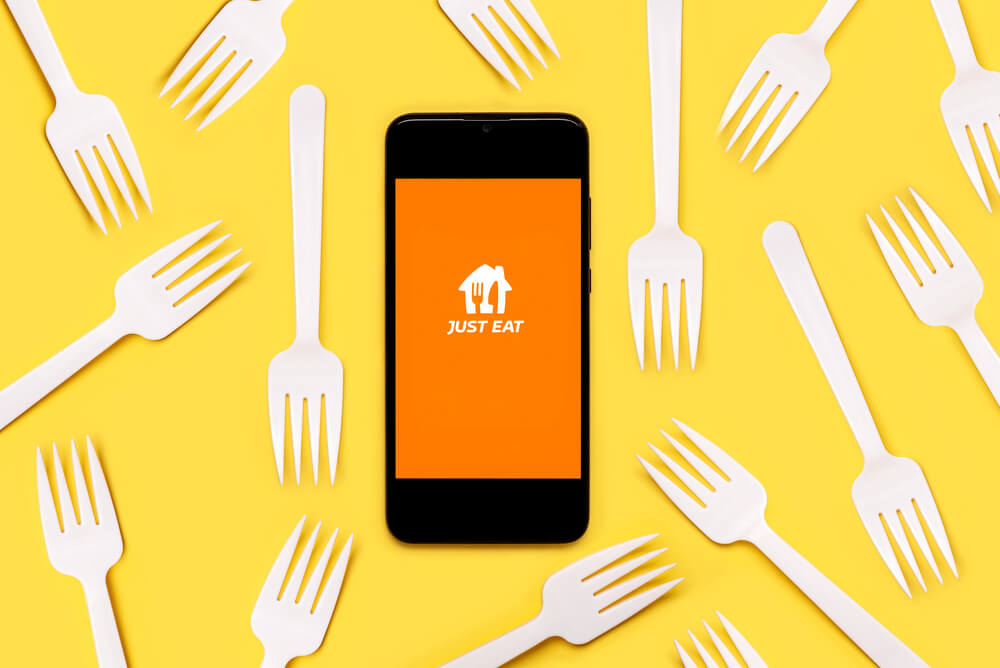
Subscribe to stay ahead with the latest updates and entrepreneurial insights!
Share this article:

Subscribe to our newsletter
Get access to the latest industry & product insights.
Quickstart Guides

You may be interested in these articles

Jungleworks 9th April 2024
Panther 9th April 2024
Jungleworks 5th April 2024
Jungleworks 4th April 2024
Find out how Jungleworks' products can help you set up & manage your online business
Have our business experts on the phone to understand your company's operations and guide you through a demo customized to your business industry.

Request a Free Demo
Our experts will contact you shortly
Step 1 of 3.
Explore our platform and launch your business with Yelo
Take a comprehensive walkthrough of the features and functionalities that Yelo provides, and learn how you can launch and grow your hyperlocal business.

Launch your Hyperlocal Business
Get started with Yelo Today
Already have an account, Sign In .
Your Theme has been Selected If you wish to proceed with this, the selected theme will be applied to your live account.
If that's okay, kindly proceed ahead ., sign up for 14 days free trial..
Learn more about Yelo and its features during Yelo's 14 days free trial. You can set up your online hyperlocal store without coding and explore the platform on your own. Upgrade your plan only when you're ready.
Start your 14 days free trial.
Make the best of this opportunity, explore the platform before you pay.
Find out how Panther can help you expand your consultation business.
Build a community of doctors, lawyers, astrologers, fitness experts and many more with Panther. Connect with our business experts & get a demo customized to your business requirements.

Launch Your Consultation Business
Sign up for 14 days free trial.
Learn more about Panther and its features during Panther's 14 days free trial. You can set up your online consultation platform without coding and explore it on your own. Upgrade your plan only when you're ready.
Find out how Yelo can help you expand your business.
Have our business experts on the phone to understand your brand's operations and guide you through a demo customized to your business industry.

Find out how Tookan can help you set up and grow your online delivery & logistics business
Connect with our product specialists to understand how the world's fastest-growing companies use Tookan to optimize deliveries.

Get in Touch
Our business experts will contact you shortly
Explore the Tookan platform for your business and get started today
Take a comprehensive walkthrough of the features and functionalities that Tookan provides, and learn how you can start managing your dispatch and delivery operations in a smoother manner.

Get Started for Free
Your online delivery platform is just one step away
Learn more about Tookan and its features during the 14 days free trial. You can start managing your operations with Tookan without coding. White-label your platform or upgrade your plan only when you're ready.
Our team will get in touch with you for the next steps, For questions or rush request please email [email protected]
Our Product Specialist will get in touch with you for the next steps. Click on the button below to see how your website will look like.
Get your Tech, sorted!

Join us for a live demo!
We'll walk you through the product suite and answer all your questions about Jungleworks.

Presentations made painless
- Get Premium
McDonald's: Business Model, SWOT Analysis, and Competitors 2023
Inside This Article
In this blog article, we will delve into McDonald's, one of the world's leading fast-food chains, and explore its business model, conduct a SWOT analysis, and identify its key competitors for the year 2023. McDonald's has built an empire on its ability to provide quick, affordable, and consistent meals to millions of customers worldwide. By examining its strengths, weaknesses, opportunities, and threats, we can gain valuable insights into the company's current standing and future prospects. Furthermore, we will also analyze the competitive landscape, identifying the players that pose a challenge to McDonald's dominance in the fast-food industry.
What You Will Learn:
- Who owns McDonald's and the significance of its ownership structure in relation to its global success.
- The mission statement of McDonald's and how it guides the company's operations and decision-making.
- How McDonald's generates its revenue and the key factors that contribute to its financial success.
- An overview of McDonald's Business Model Canvas, highlighting the key elements that make up its business model.
- The main competitors of McDonald's in the fast-food industry and the strategies they employ to challenge its market dominance.
- A comprehensive SWOT analysis of McDonald's, evaluating its strengths, weaknesses, opportunities, and threats in the current market landscape.
Who owns McDonald's?
Major shareholders.
McDonald's, the global fast food giant, has a diverse ownership structure. The company is publicly traded on the New York Stock Exchange (NYSE) under the ticker symbol "MCD." This means that anyone can become a partial owner of McDonald's by purchasing shares of its stock.
As of the latest available information, the major shareholders of McDonald's include institutional investors such as Vanguard Group, BlackRock, and State Street Corporation. These financial institutions manage large amounts of money on behalf of their clients, including retirement funds, pension plans, and mutual funds. They hold significant ownership stakes in McDonald's, often in the form of millions of shares.
Founding Family
The founding family of McDonald's, the McDonald brothers, Richard and Maurice, initially owned the original restaurant in San Bernardino, California. However, after the company was franchised and expanded, they sold their ownership stake to Ray Kroc, who joined them as a franchise agent in 1954. Ray Kroc went on to become the driving force behind the rapid growth of McDonald's and eventually bought out the McDonald brothers' ownership in 1961.
Franchisees
A significant portion of McDonald's ownership lies in the hands of its franchisees. These are independent business owners who have purchased the rights to operate a McDonald's restaurant under the company's established brand and system. Franchisees are responsible for managing their restaurants and ensuring they adhere to McDonald's standards.
McDonald's has a vast network of franchisees worldwide. These individuals or organizations own and operate thousands of McDonald's restaurants, contributing to the company's success and growth. Franchisees benefit from the global recognition and marketing power of the McDonald's brand while sharing a portion of their revenue with the company.
Individual and Small Shareholders
Apart from institutional investors and franchisees, McDonald's also has individual and small shareholders. These can include retail investors, employees, and other individuals who have purchased shares of McDonald's stock. While their ownership stakes may be relatively small compared to major shareholders, they collectively contribute to the dispersion of ownership and the democratization of McDonald's ownership structure.
In summary, McDonald's ownership is widely distributed among various stakeholders. Major institutional investors, the founding family, franchisees, and individual shareholders all play a role in owning and shaping the future of McDonald's. This broad ownership structure reflects the company's commitment to providing investment opportunities and spreading the benefits of its success across a wide range of individuals and organizations.
What is the mission statement of McDonald's?
Introduction.
McDonald's, the iconic fast-food chain that has become a global household name, operates with a clear mission statement that guides its strategic decisions and business practices. This section will delve into the mission statement of McDonald's and shed light on how it shapes the company's overall objectives and customer experience.
McDonald's Mission Statement
McDonald's mission statement is as follows: "To be our customers' favorite place and way to eat and drink." This concise yet powerful mission statement encapsulates the core essence of McDonald's business model. It emphasizes the company's commitment to providing an exceptional dining experience for its customers, making McDonald's their go-to choice when it comes to satisfying their hunger and thirst.
Customer Centricity
At the heart of McDonald's mission statement lies a strong focus on customer satisfaction. By aiming to be their customers' favorite place and way to eat and drink, McDonald's places the needs and preferences of their customers at the forefront of their operations. This customer-centric approach is evident in various aspects of the McDonald's experience, including menu offerings, service quality, and overall convenience.
Menu Innovation and Adaptability
In order to fulfill its mission statement, McDonald's continuously strives to innovate and adapt its menu offerings to cater to evolving customer tastes and preferences. Whether it's introducing healthier options, plant-based alternatives, or limited-time promotions, McDonald's recognizes the importance of staying relevant in an ever-changing market. This commitment to menu innovation allows McDonald's to maintain its status as a favorite choice for customers seeking a wide variety of food and beverage options.
Consistency and Quality
Another key aspect of McDonald's mission statement is its commitment to providing a consistent and high-quality dining experience. From food preparation to service delivery, McDonald's places great emphasis on maintaining the highest standards across its global chain of restaurants. This dedication to consistency ensures that customers can rely on McDonald's to deliver the same level of quality, taste, and experience, regardless of their location.
McDonald's mission statement, "To be our customers' favorite place and way to eat and drink," serves as a guiding principle for the company. It highlights McDonald's commitment to customer satisfaction, menu innovation, adaptability, consistency, and quality. By adhering to this mission statement, McDonald's continues to thrive as a leading fast-food chain, delighting customers around the world with its iconic offerings and exceptional dining experience.
How does McDonald's make money?
Revenue streams.
McDonald's, the global fast-food giant, generates its revenue through various streams. Let's delve into the key sources that contribute to the company's profitability:
Franchise Fees and Rent
One of the primary ways McDonald's generates revenue is through franchise fees and rent. As a franchisor, the company grants individuals or entities the right to operate a McDonald's restaurant. In return, franchisees pay an initial fee to acquire the franchise, followed by ongoing royalties based on a percentage of their sales. Additionally, franchisees pay rent to McDonald's for the use of the company's real estate, further contributing to the company's revenue.
Company-Operated Restaurants
McDonald's also operates a significant number of its own restaurants worldwide. These company-operated restaurants generate revenue through direct sales to customers. By maintaining a portion of restaurants under its direct control, McDonald's can ensure consistency in quality, service, and brand standards. The revenue from these restaurants serves as a vital source of income for the company.
Licensing and Royalties
In addition to franchising, McDonald's generates revenue through licensing and royalties. The company licenses its famous brand and trademarks to third-party manufacturers, retailers, and suppliers, allowing them to produce and sell products such as toys, apparel, and promotional items featuring the iconic Golden Arches. McDonald's collects royalties from these licensed products, bolstering its revenue without directly operating the businesses involved.
Menu Innovation and Pricing Strategy
McDonald's continually invests in menu innovation to attract customers and increase sales. By introducing new limited-time offerings, seasonal items, and promotional deals, the company entices customers to visit more frequently and try new menu items. Additionally, McDonald's employs a strategic pricing strategy to maximize profitability. Through careful analysis of costs, market demand, and competition, the company sets prices that balance customer value with profit margins.
Investment Income
Beyond its core operations, McDonald's also generates revenue through investments. The company invests its excess cash in various financial instruments, including bonds, stocks, and other income-generating assets. By earning interest, dividends, and capital gains from these investments, McDonald's diversifies its revenue streams and can further strengthen its financial position.
In conclusion, McDonald's employs a multi-faceted approach to generate revenue. Through franchise fees and rent, company-operated restaurants, licensing and royalties, menu innovation and pricing strategy, and investment income, the company ensures a steady flow of funds while maintaining its position as a global leader in the fast-food industry.
McDonald's Business Model Canvas Explained
Introduction to the business model canvas.
The Business Model Canvas is a strategic management tool that provides a holistic view of how a business operates. It consists of nine essential building blocks that help organizations describe, analyze, and design their business models. One of the most iconic examples of a successful business model is McDonald's, the global fast-food giant. In this section, we will explore McDonald's Business Model Canvas in detail to understand how the company has achieved its remarkable success.
Key Partnerships
McDonald's understands the importance of building strategic partnerships to enhance its business model. The company collaborates with various entities, including suppliers, franchisees, and advertising agencies, to ensure smooth operations and consistent brand messaging. By establishing strong relationships with its partners, McDonald's can access a wide range of resources, such as high-quality ingredients, real estate, and marketing expertise. These partnerships contribute to the overall efficiency and sustainability of McDonald's business model.
Key Activities
At the core of McDonald's business model are its key activities, which revolve around delivering quick and convenient food to its customers. These activities include food preparation, supply chain management, restaurant operations, and marketing. McDonald's has perfected its standardized processes, allowing it to serve millions of customers worldwide with consistent quality and speed. The company's emphasis on operational excellence and continuous improvement enables it to maintain a competitive edge in the fast-food industry.
Key Resources
McDonald's relies on a variety of key resources to support its business model. These resources include physical assets, such as restaurant buildings, kitchen equipment, and delivery vehicles, as well as intangible assets like its brand reputation and customer loyalty. Furthermore, the company's extensive network of franchisees plays a crucial role in expanding its reach and market penetration. By leveraging these key resources effectively, McDonald's ensures the smooth functioning of its business operations and sustains its competitive advantage.
Value Proposition
The value proposition of McDonald's revolves around offering affordable, convenient, and consistent fast food to its customers. The company focuses on delivering a unique combination of speed, quality, and affordability, appealing to a wide range of consumers. McDonald's menu offers a variety of options that cater to different tastes and dietary preferences, ensuring there is something for everyone. Additionally, the company's emphasis on cleanliness, customer service, and a family-friendly atmosphere further enhances its value proposition.
Customer Segments
McDonald's targets a broad range of customer segments, including families, students, working professionals, and individuals seeking quick and affordable meals. By appealing to diverse demographics, McDonald's can capture a significant portion of the fast-food market. The company has also recognized the importance of adapting to changing customer preferences and trends, resulting in the introduction of healthier menu options and customizable choices. This customer-centric approach allows McDonald's to maintain its relevance and connect with a wide range of consumers.
To deliver its value proposition to customers, McDonald's utilizes multiple channels. The primary channel is its extensive network of physical restaurants worldwide, which allows customers to dine in, take out, or use the drive-thru service. Additionally, the company has embraced technology and online platforms to enhance customer convenience. Through mobile apps, online ordering, and delivery partnerships, McDonald's expands its reach and provides customers with flexible options to access their favorite meals.
Customer Relationships
McDonald's places significant emphasis on building and maintaining strong customer relationships. The company understands the importance of consistently meeting customer expectations and delivering a positive experience. Whether through friendly staff interactions, clean and comfortable dining areas, or efficient service, McDonald's aims to create a welcoming environment that encourages repeat visits and fosters customer loyalty. Moreover, the company actively engages with customers through various marketing initiatives and social media channels, ensuring continued brand engagement and feedback.
McDonald's revenue streams primarily come from the sale of food and beverages through its restaurants. The company generates income through various channels, including dine-in, take-out, drive-thru, delivery, and catering services. McDonald's also earns revenue from franchising fees, rental income, and royalties paid by franchisees. This diversified revenue model contributes to the company's financial stability and allows for continued expansion and innovation.
Cost Structure
McDonald's cost structure is designed to maximize efficiency and profitability. The company focuses on cost control across its value chain, including procurement, operations, and marketing. By leveraging economies of scale, standardized processes, and supply chain management, McDonald's can achieve cost savings in sourcing ingredients, streamlining operations, and optimizing marketing campaigns. This cost-conscious approach enables the company to offer affordable prices while maintaining healthy profit margins.
McDonald's Business Model Canvas provides a comprehensive overview of how the company operates and creates value for its customers. By strategically managing its key partnerships, activities, resources, and customer relationships, McDonald's has built a successful and globally recognized brand. The company's ability to consistently deliver on its value proposition, adapt to changing customer preferences, and maintain cost efficiency has been instrumental in its long-standing success in the fast-food industry.
Which companies are the competitors of McDonald's?
Fast food giants.
As the largest fast-food chain in the world, McDonald's faces stiff competition from several other industry giants. Here are some of the main competitors of McDonald's:
1. Burger King
Burger King, often referred to as the "Home of the Whopper," is one of the most recognizable fast-food chains globally. Known for its flame-grilled burgers and extensive menu, Burger King poses a significant threat to McDonald's market share. The company prides itself on offering a diverse range of options to cater to different tastes and preferences.
Wendy's, with its iconic square-shaped burgers, has been a long-standing competitor of McDonald's. Wendy's focuses on fresh ingredients and made-to-order meals, appealing to consumers seeking a higher quality fast-food experience. The company has also gained popularity for its bold and sassy social media presence, engaging with customers in a unique way.
Although primarily known for its sandwiches, Subway competes with McDonald's as a prominent fast-food chain. Subway's emphasis on healthier options, customization, and its "Eat Fresh" slogan attracts health-conscious customers who prefer sandwiches over burgers. With its wide range of toppings and bread options, Subway offers a more personalized dining experience.

4. Taco Bell
Taco Bell, specializing in Mexican-inspired fast food, is another significant competitor for McDonald's. With its unique menu items and affordable pricing, Taco Bell appeals to a younger demographic and those seeking a quick, flavorful alternative to traditional burgers. The company's constant innovation and limited-time offerings help maintain customer interest and loyalty.
Kentucky Fried Chicken (KFC) competes against McDonald's in the fast-food industry with its famous fried chicken recipes. Known for its "finger-lickin' good" taste, KFC offers a variety of chicken-based meals and sides. The brand's strong global presence and its ability to adapt its menu to local tastes make it a formidable competitor to McDonald's.
These are just a few examples of the major competitors that McDonald's faces in the fast-food industry. While each company has its unique selling points and target audience, they all strive to carve out their share of the market and challenge McDonald's dominance. As the competition continues to evolve, it will be interesting to see how McDonald's responds to stay ahead in this highly competitive landscape.
McDonald's SWOT Analysis
McDonald's has several strengths that have contributed to its success as a global fast-food chain.
Brand recognition: McDonald's is one of the most well-known and recognizable brands in the world. Its golden arches logo and iconic characters like Ronald McDonald have become synonymous with fast food. This strong brand recognition has allowed McDonald's to establish a wide customer base and maintain customer loyalty.
Global presence: McDonald's operates over 37,000 restaurants in more than 100 countries, making it one of the largest fast-food chains globally. This extensive global presence gives McDonald's a competitive advantage as it can cater to a diverse range of customers and benefit from economies of scale.
Strong supply chain: McDonald's has built a robust and efficient supply chain that ensures consistent quality and timely delivery of ingredients to its restaurants worldwide. This strength allows McDonald's to maintain its standard menu offerings and respond quickly to changing customer preferences.
Menu innovation: McDonald's continuously introduces new menu items and limited-time promotions to cater to evolving consumer tastes. By adapting its menu to accommodate healthier options, vegetarian choices, and regional preferences, McDonald's has successfully remained relevant and appealing to a wide range of customers.
Despite its strengths, McDonald's also faces certain weaknesses that could hinder its growth and competitiveness.
High employee turnover: The fast-food industry, including McDonald's, is notorious for high employee turnover rates. Frequent turnover can result in increased training costs, reduced efficiency, and lower customer service quality. McDonald's needs to address this weakness by implementing effective employee retention strategies.
Negative public perception: McDonald's has faced criticism and negative public perception regarding its contribution to obesity, environmental sustainability, and the treatment of animals. These concerns have led some consumers to choose healthier and more socially responsible alternatives. McDonald's must actively address these issues and emphasize its commitment to sustainable practices and healthier food options.
Overdependence on certain markets: Although McDonald's has a global presence, it heavily relies on specific markets, such as the United States, Europe, and China, for a significant portion of its revenue. Any economic or political instability in these markets could impact McDonald's financial performance. Diversification into untapped markets could help mitigate this weakness.
Opportunities
McDonald's has identified several opportunities that can further enhance its market position and profitability.
Expanding into emerging markets: McDonald's can capitalize on the rising middle class and increasing disposable incomes in emerging markets, such as India, Brazil, and Southeast Asian countries. By tailoring its menu offerings and marketing strategies to local preferences, McDonald's can tap into these untapped markets and achieve significant growth.
Digitalization and technology: McDonald's can leverage technology to enhance customer experience and streamline operations. Implementing mobile ordering apps, self-service kiosks, and digital payment systems can improve convenience and speed of service for customers, while also reducing labor costs and increasing efficiency.
Healthier food options: As consumers become more health-conscious, there is an opportunity for McDonald's to expand its offering of healthier food options. By incorporating more nutritious ingredients, reducing sodium and sugar content, and providing transparent nutritional information, McDonald's can attract health-conscious customers who may have previously avoided fast food.
McDonald's faces several threats that could impact its future growth and profitability.
Intense competition: The fast-food industry is highly competitive, with numerous global and local players vying for market share. Competitors like Burger King, Wendy's, and Subway offer similar products and constantly innovate to attract customers. McDonald's must continually adapt and differentiate itself to maintain its competitive edge.
Changing consumer preferences: Consumer preferences are evolving, with a growing demand for healthier and more sustainable food options. If McDonald's fails to adapt its menu and practices to align with these changing preferences, it risks losing customers to competitors that offer healthier alternatives.
Regulatory challenges: McDonald's operates in multiple countries, each with its own regulations regarding food safety, labor laws, and advertising practices. Adhering to these regulations and potential changes can be challenging and costly for McDonald's. Compliance failures or negative publicity related to regulatory issues can damage the brand's reputation and result in financial penalties.
In conclusion, McDonald's has several strengths that have contributed to its success, such as strong brand recognition, global presence, strong supply chain, and menu innovation. However, it also faces weaknesses, including high employee turnover and negative public perception. To capitalize on opportunities, McDonald's can expand into emerging markets, leverage digitalization, and offer healthier food options. Nevertheless, it must be aware of threats such as intense competition, changing consumer preferences, and regulatory challenges. By addressing these weaknesses, capitalizing on opportunities, and mitigating threats, McDonald's can continue to thrive in the highly competitive fast-food industry.
Key Takeaways
- McDonald's is a publicly traded company, meaning it is owned by shareholders who hold its stock.
- The mission statement of McDonald's is to "be our customers' favorite place and way to eat and drink."
- McDonald's primarily generates revenue through the sale of its food and beverages, both at its physical locations and through delivery services.
- McDonald's business model canvas encompasses key elements such as customer segments, value propositions, channels, customer relationships, revenue streams, key resources, key activities, key partnerships, and cost structure.
- Some of McDonald's main competitors in the fast-food industry include Burger King, Wendy's, Subway, and KFC.
- McDonald's SWOT analysis highlights its strengths, weaknesses, opportunities, and threats, such as its strong global brand recognition, potential for diversification, increasing competition, and changing consumer preferences.
In conclusion, McDonald's is a global fast-food giant that has successfully dominated the industry for decades. While it started as a small restaurant in San Bernardino, California, today it is owned by millions of shareholders around the world. Its mission statement focuses on providing quality food, service, and a positive experience for its customers.
McDonald's makes money through various revenue streams, including sales from its restaurants, franchising fees, and rental income. Its business model canvas is built on key elements such as customer segments, value proposition, channels, customer relationships, revenue streams, key activities, key resources, and key partnerships.
Despite its enormous success, McDonald's faces fierce competition from various companies in the fast-food industry. Its main competitors include Burger King, Subway, Wendy's, and KFC. These companies continuously strive to attract customers with their own unique value propositions, menu offerings, and marketing strategies.
Conducting a SWOT analysis of McDonald's reveals its strengths in brand recognition, global presence, and operational efficiency. However, it also identifies weaknesses such as high employee turnover and negative public perception of fast food. Opportunities for McDonald's lie in expanding its menu options and embracing healthier food trends, while threats include changing consumer preferences and increased competition from healthier fast-food alternatives.
Overall, McDonald's remains a dominant force in the fast-food industry, constantly adapting to changing market conditions and customer preferences. Its strong brand, global reach, and ability to generate consistent revenue have solidified its position as one of the most recognizable and successful fast-food chains in the world.
Does McDonalds use the SWOT analysis?
Yes, McDonald's uses the SWOT analysis as a strategic planning tool to evaluate its strengths, weaknesses, opportunities, and threats. This analysis helps McDonald's identify areas of its business that need improvement, as well as potential opportunities for growth. By understanding its internal and external factors, McDonald's can make informed decisions and develop strategies to remain competitive in the fast-food industry.
What are the strengths of McDonalds?
Brand recognition and global presence: McDonald's is one of the most well-known and recognizable brands in the world. The golden arches logo is instantly identifiable, and the company has a strong presence in over 100 countries. This gives McDonald's a significant advantage in terms of customer trust and brand loyalty.
Strong marketing and advertising: McDonald's consistently invests heavily in marketing and advertising campaigns to promote its products and maintain its brand image. This has helped the company to stay relevant and attract a wide customer base, including children, teenagers, and families.
Efficient supply chain management: McDonald's has established a highly efficient supply chain management system, ensuring that its restaurants receive consistent and timely deliveries of ingredients. This enables them to maintain quality and consistency across their global operations.
Cost leadership strategy: McDonald's has been able to achieve cost leadership in the fast-food industry through economies of scale, standardized processes, and efficient operations. This allows them to offer affordable prices to customers, which is a significant strength in attracting value-conscious consumers.
Diverse menu options: McDonald's offers a diverse menu that caters to a wide range of customer preferences and dietary needs. This includes vegetarian options, salads, fish, chicken, and various burger choices. This diversity helps McDonald's to appeal to a broader customer base and adapt to changing consumer trends.
Innovation and adaptation: McDonald's continuously innovates and adapts its menu and operations to meet evolving customer demands and preferences. They introduce new products, collaborate with popular brands, and invest in technology to improve the customer experience, such as self-order kiosks and mobile ordering.
Strong franchising system: McDonald's operates under a franchise model, which allows them to expand rapidly while minimizing capital investment. The company benefits from franchisees' local expertise and financial contributions, making it easier to penetrate new markets and maintain a global presence.
Social responsibility initiatives: McDonald's has actively engaged in various social responsibility initiatives, such as Ronald McDonald House Charities, which supports families with sick children, and sustainable sourcing practices. These initiatives help enhance the company's reputation and appeal to socially conscious consumers.
Strong financial performance: Despite facing competition and economic challenges, McDonald's has consistently delivered strong financial results. The company's financial stability and profitability demonstrate its ability to navigate market fluctuations and generate sustainable growth.
Continuous improvement and operational efficiency: McDonald's is committed to continuous improvement and operational efficiency in its restaurants. They regularly invest in employee training, technology upgrades, and process improvements to enhance service speed, quality, and customer satisfaction.
What is McDonalds biggest weakness?
One of McDonald's biggest weaknesses is its association with unhealthy and processed fast food. The company has faced criticism for its menu offerings, which are often high in calories, fat, and sodium. This weakness has led to a decline in consumer perception and a shift towards healthier alternatives among some customers. Additionally, McDonald's has faced negative publicity regarding its environmental impact, labor practices, and animal welfare issues, which further contributes to its weaknesses.
What challenges are McDonalds facing?
McDonald's is facing several challenges, including:
Intense competition: The fast-food industry is highly competitive, with numerous competitors offering similar products and services. McDonald's faces competition not only from other fast-food chains like Burger King and Wendy's, but also from quick-service restaurants, cafes, and even grocery stores.
Changing consumer preferences: Consumer preferences are constantly evolving, with a growing demand for healthier, fresher, and more sustainable food options. McDonald's has been criticized for its menu, which is often perceived as unhealthy and lacking in variety. Adapting to changing consumer preferences and offering healthier alternatives has been a challenge for the company.
Rising labor costs: McDonald's, like many other businesses, is facing challenges related to rising labor costs. The company has faced pressure to increase wages for its employees, which can impact its profitability and operating margins.
Sustainability concerns: There is increasing societal focus on sustainability, including issues such as packaging waste, animal welfare, and environmental impact. McDonald's has faced criticism for its use of single-use plastics and its sourcing practices. Addressing these concerns and implementing sustainable practices can be a challenge for the company.
Technological advancements: The rapid advancement of technology has transformed the way consumers interact with businesses. McDonald's is faced with the challenge of adapting to these technological changes, such as implementing mobile ordering and payment systems, self-service kiosks, and delivery services, to meet customer expectations and stay competitive.
Negative public perception: McDonald's has faced criticism regarding various aspects of its business, including labor practices, marketing to children, and the impact of its food on public health. These negative perceptions can affect the company's reputation and customer loyalty, requiring ongoing efforts to address and improve public perception.
Overall, McDonald's faces the challenge of staying relevant and appealing to a changing consumer base while addressing concerns related to health, sustainability, and labor practices.
Want to create a presentation now?
Instantly Create A Deck
Let PitchGrade do this for me
Hassle Free
We will create your text and designs for you. Sit back and relax while we do the work.
Explore More Content
- Privacy Policy
- Terms of Service
© 2023 Pitchgrade
- Search Search Please fill out this field.
- McDonald's Today
Business Model
- Franchises in Demand
MCD Financial Picture
Growth strategy, key challenges, the bottom line.
- Company Profiles
- Consumer Discretionary
How McDonald's Makes Money
Efficiently catering to the basic need to eat
:max_bytes(150000):strip_icc():format(webp)/Dr.JeFredaR.Brownheadshot-JeFredaBrown-1e8af368a1ea4533a21868d8a951895a.jpg)
The story of McDonald's ( MCD ) often begins with Ray Kroc, the native Chicago milkshake mixing machine salesperson who had the vision to see what the business model deployed by one of his clients, Speedee Service System, could become. Speedee Service System, launched in 1948, was the brainchild of two brothers, Richard James (Dick) and Maurice James (Mac) McDonald, who successfully applied the drive-in concept to food delivery and, ultimately, franchising opportunities.
Impressed by what he saw, Ray Kroc became their franchise agent in 1954. He opened up the first McDonald's franchise in 1955 and bought out the McDonald brothers six years later for the then hefty sum of $2.7 million. The rest is part of the entrepreneurial lore that is the hallmark of iconic businesses.
Key Takeaways
- McDonald's is the most valuable fast-food chain in the world.
- The company makes money by leveraging its product, fast food, to franchisees who have to lease properties, often at large markups, that are owned by McDonald's.
- Approximately 93% of all McDonald's locations worldwide are franchises.
- Franchisees are lured by the impressive margins that make McDonald's franchises an almost guaranteed moneymaker.
- McDonald's remains committed to growth, continuing its aggressive deployment of the three growth accelerators—EOTF, delivery, and digital.
McDonald's Today
Since its founding, the enterprise has about 38,000 restaurants globally that serve close to 68 million customers in 118 countries per day. That represents about 1% of the world's population who want a burger, fries, and/or chicken nuggets as quickly as possible. It has, effectively, morphed into the most popular family restaurant that appeals to children and adults alike and emerged as the dominant force in the quick service restaurant end of the market.
This restaurant model isn't unique to McDonald's. In fact, there are a number of other popular franchises in this category, including KFC and Taco Bell ( YUM ), Wendy’s ( WEN ), and Burger King. McDonald's ruled as one of the most valuable fast-food chains in the world with a brand value of over $40 billion (Starbucks edged out McDonald's for the #1 spot). McDonald's is consistently among the leaders of this market segment in terms of brand recognition, overall sales, and the number of restaurants globally, along with Starbucks ( SBUX ), KFC, Domino's, and Subway.
On the way to serving hundreds of billions of people, McDonald's has blazed multiple corporate trails since its 1955 incorporation, such as franchising and institutionalized training. McDonald's even had a mission statement long before mission statements were a thing. "Quality, Service, Cleanliness and Value" is self-explanatory, and McDonald's has set standards for at least the first and fourth of those qualities.
McDonald's makes money by leveraging its product (fast food) to franchisees who have to lease properties that are owned by McDonald's. This often comes at a large markup. As reported in the 2021 10-K , 37,295 (93%) McDonald's locations were franchised at the end of 2021.
The advantage of this model is that the revenue stream (rent and royalty income received from franchisees) is far more stable and predictable. The operating costs, on the other hand, are measurably lower, which allows for an easier path to profitability . McDonald's can leverage its market position to negotiate deals because it has control over the land and long-term leases. This is akin to a subscription, where the subscriber (the franchisee) pays a fixed amount each month.
According to industry analysts, McDonald's keeps about 82% of the profit generated by franchisees, compared with only about 16% from its company-operated locations, further trimmed by the costs incurred in operating these units. In other words, it costs way more money to run your own store than it does to sit back and collect cash. Note that McDonald's company-operated locations earn more revenue for the entire company than the franchisees; however, the overhead expenses are larger for the company-operated locations than for the franchisees, which collect more overall revenue on an absolute level.
Why McDonald's Franchises Are in Demand
McDonald's has notoriously strict criteria for its franchisees (including net worth and liquidity ). Franchisees are also responsible for paying salaries, ordering supplies, and paying the rent or mortgage. So, why become a franchisee? The lure is that McDonald's provides its franchisees with an almost guaranteed moneymaker due to the impressive margins.
The restaurant industry is infamous for its turnover. As any restaurateur will tell you, one major reason for this is that the margins can be thinner than a slice of processed American cheese. Yet, McDonald's operating margins are Double Quarter Pounder thick—north of 40%. How is that possible in a business whose very purpose is to provide inexpensive food? The answer lies in the fact that some food and drink items, such as coffee, for instance, are quite inexpensive to prepare. They are then sold for a few times their price.
McDonald's operates with the following global business segments: the U.S., International Operated Markets, and International Developmental Licensed Markets and Corporate. Each sector accounted for 38%, 53%, and 9% of revenues, respectively, as of the company's most recent annual report .
McDonald's has a track record of paying dividends on its common stock. In fact, the company has raised its dividend every year since it paid its first one in 1976.
Financial Statements
According to the company's 10-K, 2021 free cash flow was $7.1 billion, a 46% increase over 2020, and 1,500 new stores were opened worldwide.
McDonald's has a long-term goal of franchising approximately 95% of its locations. McDonald's will continue to make progress toward this long-term goal primarily by re-franchising restaurants to conventional licensees . As a result of the continued evolution of its business model, several organizational changes to its global business structure were implemented that are designed to continue the company's efforts toward efficiently driving growth as a better McDonald’s through the Velocity Growth Plan.
The Velocity Growth Plan, which was first introduced in 2017, is McDonald's customer-centric strategy that focuses on the key drivers of the business, namely food, value, and customer experience. Here's its main focus:
- Retaining Existing Customers: Focusing on areas where it already has a strong foothold in the Informal Eating Out category, including family occasions and food-led breakfast.
- Regaining Customers Who Visit Less Often: Recommitting to areas of historic strength, namely quality, taste, quality, and convenience of its product: food.
- Converting Casual to Committed Customers: Building stronger relationships with customers so they visit more often, by elevating and leveraging the McCafé coffee brand and enhancing snack and treat offerings.
McDonald's remains committed to continuing its aggressive deployment of the three growth accelerators. The growth accelerators are:
- Experience of the Future: Restaurant modernization and technological upgrades to transform the restaurant service experience and enhance customer perceptions of the brand .
- Digital: By evolving the technology platform, McDonald's is expanding choices for how customers order, how they pay, and how they're served through additional functionality on its global mobile app, self-order kiosks, and technologies that enable conveniences such as table service and curbside pick-up.
- Delivery: McDonald's expanded the number of restaurants offering delivery. It is now available in over half of the global system. McDonald's was and intends to be quite proactive in keeping up with the current trends when it comes to expanding its brand and business. The company announced a partnership with Uber Eats for home delivery for the first time in the U.S. and followed that up by adding Doordash and GrubHub. These partnerships are part of a strategy to keep up with the newer generations who prefer home delivery over pick-up.
McDonald's has managed to stay comfortably ahead of its main competitors in the fast food arena, such as Burger King, Wendy's, and KFC, but its key challenge might just be consumers demanding healthier, organic menu choices coupled with fast-food convenience.
Over the past few years, another restaurant model, one that offers consumers freshly prepared, higher-quality food in an informal setting and with efficient counter service, has been making a bid to garner the attention of the consumer, or more appropriately, their palates. Dubbed as fast-casual restaurants, these entities (Chipotle ( CMG ), Shake Shack ( SHAK ), and Cheesecake Factory ( CAKE ), among others) have been making inroads into the space long dominated by chains like McDonald's.
Fast-casual differs from fast food in that its aim is to provide consumers with healthier selections but with fast food convenience at a slightly higher price point that consumers would be willing to pay. The growing consumption trends for food that is healthy, economical, and available with minimal wait times have begun to eat into the market share of leading fast-food restaurants.
This didn't go unnoticed by McDonald's. In 2018, it announced that it was removing all preservatives, fake colors, and other artificial ingredients from seven of its burger selections. Its menu features a Southwest Grilled Chicken Salad, and you can get apple slices with a kid's Happy Meal.
What's Included in a McDonald's Franchise Agreement?
According to the company, McDonald's provides franchisees with a long-term lease for the location and the owner is then responsible for all equipment, seating, décor, and signage. Franchisees are also responsible for reinvesting capital back into their businesses over time to make improvements and modernize.
How Much do McDonald's Franchise Owners Make?
McDonald's franchise owners in the U.S. can expect to make over $150,000 in profits in a year; however, industry research shows that many franchisees actually earn less than this projection.
Fast food should be as stable an industry as any. People need to eat and they want their food fresh and fast without having to spend unnecessarily. That said, the industry does face challenges relating to a shift in demand toward healthy eating. A restaurant chain that sells familiarity and consistency needs to recognize that those qualities themselves are enormous assets. Even when McDonald's has an under-performing year, it's still profitable. When operating at its peak, it's a must-have stock in any comprehensive portfolio, especially since it has similarities with real estate investment trusts (REITs) as well.
McDonald's. " History ."
McDonald's. " Franchising Overview ."
McDonald's. " Home ."
McDonald's. " What countries does McDonald's operate in? "
United States Census Bureau. " U.S. and World Population Clock ."
QSR. " The QSR 50: The Fast-Food Industry's Leading Annual Report ."
McDonald's. " 2021 Annual Report ."
QSR. " Ranking The Top 50 Fast-Food Chains in America ."
McDonald's. " Our History ."
Wall Street Survivor. " McDonald's Real Estate: How They Really Make Their Money ."
Yahoo! Finance. " McDonald's Has Raised Its Dividend Every Year Since 1976 ."
McDonald's " Uber and McDonald’s to Drive Delivery Growth with Long-Term Global Strategic Partnership ."
McDonald's. " McDonald’s and DoorDash Announce Long-Term Global Strategic Partnership to Drive Growth of McDelivery ."
Cision. " McDonald's Adds Grubhub as McDelivery Partner in NYC and Tri-State Area ."
Forbes. " Why McDonald's Got Rid Of Artificial Additives In Its Burgers ."
ICSID.org. " How much do mcdonalds franchise owners make a year? "
:max_bytes(150000):strip_icc():format(webp)/GettyImages-1173584627-1bc645c4cd43406d838ce0095388f9c7.jpg)
- Terms of Service
- Editorial Policy
- Privacy Policy
- Your Privacy Choices

McDonald’s Business Model Analyzed and Explained
Editorial Team
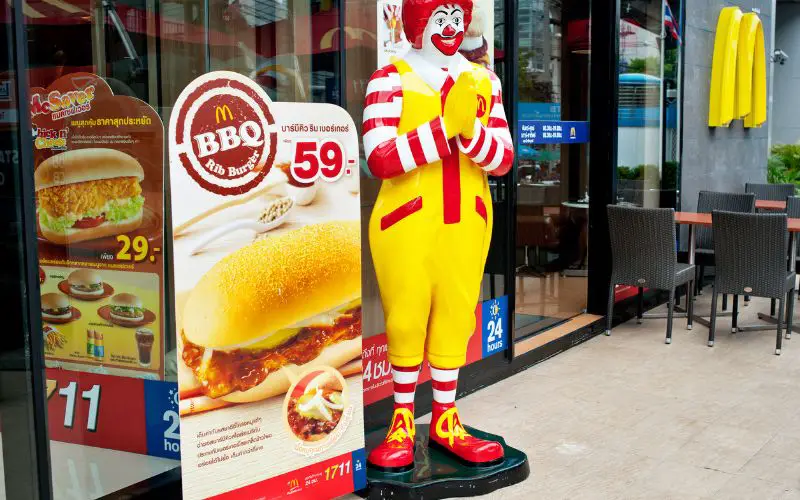
Fast food is one of the easily available, cheap, and fulfilling options, attracting thousands towards itself owing to its flavorfulness. It is by far the major reason for McDonald’s popularity, making it the largest fast-food chain globally. Such large-scale businesses are hugely responsible for globalization and a tyrant in the business market. So, let’s analyze this oldest fast-food restaurant to comprehend what makes it successful among its competitors with its revenues and future plans.
The Making Of Mcdonald’s
First opened by the McDonald brothers in San Bernardino, California, in 1940, Ray Kroc now owns McDonald’s. The startup McDonald’s was a drive-in restaurant that offered a wide selection of food items. However, in 1948 the founding members decided to create a newly envisioned version of McDonald’s by limiting the menu but increasing the quality. However, the catch was that the food would get prepared in bulk at an extensive scale. This way, it would be affordable. The initial menu consisted of hamburgers, French fries, drinks, and pies. Later, their menu items also added shakes, chicken burgers, and seafood. The fast-food chain has continued to expand at such a level over time that it has more than 34,000 outlets today operating in over 115 countries worldwide. The growth is so swift that the reports estimate that every five hours marks the opening of a new McDonald’s somewhere in the world.
McDonald’s Business Model
Since its founding in 1948, McDonald’s has opened 34,000 outlets worldwide in 115 countries. They serve up to 68 million customers daily, making up about 1% of the world’s population. We can’t deny it as it is popular among both children and adults. Plus, the company has over 1.7 employees, which makes it the second-largest private employer in the whole world. Concerning the Business model, the brothers brought forward and applied the franchise and drive-thru model to run their fast-food restaurant.
McDonald’s Earned Revenues
The US is the leading market for McDonald’s and accounts for most of its revenue, with the 14,000 restaurants generating $7.4 billion across the last calendar year. UK, Canada, Australia, France, Germany, Russia, and Hong Kong are other leading international markets, with the company amassing over $11.4 billion in revenue. The company is one of the most valuable businesses in the world, valued at over $130 billion, and this figure is constantly rising. Global sales increase by over 30% yearly, signifying that McDonald’s is an everlasting franchise.
How does McDonald’s make Money?
McDonald’s generates most of its revenue by leveraging its facilities to franchisees who must lease the franchises owned by McDonald’s at hefty markups. They also charge a considerable amount from the franchise longing for its license with loyalty.
Note that, out of its 34,000 outlets, 93% are leased by private owners, while the rest are self-owned by McDonald’s. Through this, McDonald’s receives a substantial advantage as the revenue earned is notably steady.
The additional benefit is it contributed to the low operating cost because the franchisee pays for the interior design. It, in turn, suggests more earned profit. This leasing system can be seen as a subscription by the franchisee. It also benefits the franchisees as they have the surety of the brand name.
McDonald’s 4 Ps Marketing Mix
The 4 Marketing Ps highlight the business strategies that the company employs to ladder up in the long run. McDonald’s mix and match these 4 Ps accordingly to attract the target audience, displaying the marketing techniques. These 4 Ps are:
McDonald’s rose to fame from their beef burgers. Yet, over time they started selling chicken and fish products with a wide array of desserts and drinks. The company has introduced a series of products to cater to all kinds of cuisines. We can consider an example from the Middle Eastern region, where the introduction of mcArabia was an instant hit, as the people living in that region felt represented on the international stage.
With more than 36,000 restaurants spread across the globe, McDonald’s strategic placement of their restaurants is phenomenal, with outlets always within the customer’s reach. They have outlets inside malls, kiosks at events, and restaurants in every nook and cranny of the earth. Dining at McDonald’s has become people’s hobby, as the restaurants and taste calls for it. Children especially love visiting the play areas, so it’s more likely a family restaurant partnered with a fun and clean play area.
The company intelligently uses psychological pricing strategy by rounding off all prices to .99 to make their products look more appealing and affordable. In addition to this, they also use the bundle pricing strategy, which offers discounted food bundles. It includes the make-it-a-meal option, where customers would buy a meal instead of a burger as it seemed a better choice while paying more. For good measure, McDonald’s successfully employed a cost leadership marketing strategy by hiring inexperienced employees. The trained managers train them and earn loyalty in return. It reduces the cost of hiring experienced professionals, ultimately generating more profit.
4. Promotion
McDonald’s advertising strategy is the most notable among its promotion strategies. Its unique and attractive promotions online and through TV and radio have amassed a huge viewership, bringing in more customers. It offers discount coupons and freebies. It also promotes its brand by partnering with other brands, ensuring benefits for both.
The primary target audience of McDonald’s comprises both young people and adults alike. However, the marketing towards the youth is the most evident. Ronald McDonald was introduced in 1963, and children loved the clown.
McDonald’s had taken a smart move by adding a breakfast menu and McCafe to attract business people, who could get food without waiting too long or conducting business meetings over a cup of coffee.
Another intelligent promotion strategy by McDonald’s was collaborating with major artists and other famed personalities over the years. The most recent was their collaboration with Travis Scott, where they introduced the Travis Scott Burger loved by customers, especially the youth.
Reasons Contributing To The Huge Success Of Mcdonald’s
1. consistency.
Consistency is the eminence of success, and McDonald’s has demonstrated it multiple times. Regardless of the McDonald’s outlet, the food will always taste similar. The rationale is similar to recipes and ingredients imported from the same place. Consistency helps build trust , as customers know what to expect every time they visit; hence become regular.
2. Innovation
The innovation laboratory of McDonald’s is one of the reasons why the company has achieved the position it holds in the fast food chain industry. McDonald’s has kept the grounds consistent while innovating food on the same bases. In 1975, it started the first drive-thru restaurant near a military base in Arizona to assist soldiers in getting food conveniently. The introduction of a separate breakfast menu was an instant hit among customers. Other innovations like the introduction of Fillet-o-Fish and fried chicken were fan favorites. In addition to this, food suited to the cuisine of the local culture attracts a lot of local customers. This uniqueness substantially contributed to McDonald’s success in the global food market.
Competition In The International Market
After observing the massive success of McDonald’s, many such fast-food restaurants started opening up all across the world. This spread of globalization was beneficial for spreading culture all over. The rise of such restaurants has threatened the sale of McDonald’s from time to time, which promotes healthy competition in the international market.
KFC is McDonald’s greatest competitor in the international market. This 1930-founded franchise has over 20,000 branches spread in over 120 countries. However, the crucial difference is that KFC is known for its fried chicken and constituent food products, while McDonald’s main selling point is beef. Its revenue is around $3 billion, and its sales rose for the first time last year after a gap of 17 years.
Subway is one of the world’s fastest-growing food chains. Founded in 1965, the company owns over 45,000 stores in more than 110 countries. Although Subway has a limited menu, its simplicity is one of its reasons for success. The unique feature is you can watch your food while cooking in front of you, let it cook how you like, and get it in your hands within less than five minutes. It is also seen as a healthier alternative to other fast-food joints, providing another reason for its growing success. This cleanliness, customized order, and hygiene make it popular among people.
3. Burger King
Owned by Restaurant Brands International, Burger King stands as one of the largest fast-food restaurants in the world. As the name suggests, it is one of the most sought-after food joints in the world. This 1953-founded restaurant was originally located in the US, but the locals loved it to such an extent that it now has 15,000 outlets in more than 100 countries. It makes a revenue of $4 billion while holding assets amounting to $16 billion.
4. Pizza Hut
Pizzas and burgers are the fast food most people turn to, and Pizza Hut is the pioneer of pizzas under Yum brands, likely KFC. Founded in 1958, the company has expanded to over 16,000 locations worldwide. Its vast and diverse menu, which includes different kinds of pizzas, is the reason for its massive success. The company’s monetary net worth, as of 2022, stands at $810 billion.
5. Starbucks
Founded in 1971, Starbucks is probably the most popular coffee house in the world. Its massive rise is that they have almost 24,000 locations scattered around the world where Starbucks sells its famous coffee. Its revenue sits at a whopping $19 billion while employing nearly 250,000 employees from different areas of the globe.
In addition to the aforementioned global franchises, several local franchises stand strong against giving McDonald’s sturdy competition. These franchises cater to the needs of the locals, while global franchises have a more generalized taste. All in all, we can conclude that the food industry is an ever-growing industry, and one has to be always transforming to succeed in the market.
Challenges Faced and How McDonald’s Tackles Them
Being such a large global organization brings its pros and cons. Likewise, McDonald’s has faced prime criticism over the years and has been in the spotlight multiple times. However, the organization has always been very responsive to all the criticism through their actions. Let’s discuss the challenges McDonald’s has achieved to come to its present position.
- Over the years, McDonald’s has faced many challenges related to health issues, especially in children. In response to this, they worked with experts to form a menu that would be nutritious and in accord with the guidelines. In addition to this, it started providing nutrition facts on the packaging. Since 2015, the company has stopped using animals being treated with artificial growth hormones and used only those that are free of antibiotics.
- Activists started raising concerns over McDonald’s policies affecting the environment. In response, it founded the Global Environment Committee in 1990, which suggested ways to reduce solid waste and conserve natural resources. Recently, the company switched to renewable materials for 80% of its packaging, which helps preserve the environment.
- Customers complained a lot about the costly prices of the menu items. These negative reviews also jeopardized the restaurant’s revenue as consumers turned toward other newly opened food joints. So, McDonald’s started offering discounts and loyalty rewards to win back customers. To boot, they also introduced the dollar menu to sell exclusive items up to a range of $5.
- Harassment faced by McDonald’s employees and customers was a major occurrence in the past. The authorities passed several Lawsuits, but the results only suppressed the voices over the years. To counter harassment at the workplace, McDonald’s has been very responsive those years as they took strict action against such employees. They educated the staff on how to behave in the office and defend themselves in such scenarios. They have also launched several policies against discrimination. However, after all of this, harassment at the workplace still exists. The company should work harder to eradicate this evil.
What Has McDonald’s Planned For Its Future?
McDonald’s unveiled a new growth plan in November 2020. They did so intending to invest in the 3 Ds: Digital, Delivery, and Drive Thru. This shift has been done primarily due to the coronavirus pandemic. Lifestyle has grown faster, and hence demands have to be fulfilled rapidly. Therefore, the company decided to increase the number of drive-thru restaurants, even though almost 65% of their restaurants have one.
For good measure, McDonald’s has taken adequate steps to enhance the digital capabilities of restaurants. They provide their customers to place their orders through kiosks, implying they can skip the long order placement lines. Their food will be brought right to them, at their table, and customers will not have to go through the hassles of waiting long for their food. Moreover, Mcdonald’s also plans to introduce mobile ordering. It means when you place an order through your mobile online, you can also skip the drive-thru line, as the staff delivers the ordered food to your curbside.
They also make their already extensive system larger so that people can access McDonald’s franchises near them. It is to be available to all McDonald’s lovers within a 3km radius. They also aim to partner with other delivery services to speed up the process.
Considering this, the company has designed numerous plans to strengthen its interpersonal relationships with customers by catering to family occasions and serving food-led breakfasts. They also plan to invest heavily in their McCafe service as it has been a customer favorite over the past few years. This way, they tend to convert casual customers to regular customers. In addition, they have decided to revamp restaurants and create a more convenient and enjoyable ambiance.
Another step the company is taking is introducing plant burgers, concerning the veg population. It will also contribute to the environment, so double the benefits. Yet, McDonald’s is presently testing different versions of the Plant burger in its laboratory.
One of McDonald’s aims is to give back to the environment. They aim to source their food from quality ingredients, drive climate action campaigns to protect the planet, connect with communities in times of need, and provide employment opportunities. In this regard, they aim to convert 100% of their packaging to ensure it is environmentally friendly and biodegradable. They also donate millions of pounds of food each year to help families in need by employing over 2 million people worldwide.
In the business arena, the company has decided to franchise restaurants and upgrade their number to meet consumer demand. They aim to increase the total savings by at least 5% annually. Moreover, shareholders are going to get greater cash returns. It would build a stronger bond between the shareholders and the company itself.
McDonald’s is the most famous fast-food restaurant globally, and with around 40,000 franchises, it is one of the most successful businesses in the world. Their innovative ideas are hugely responsible for the multitudes of success the company has earned. Due to being such a tycoon, it shares its fair trade of problems. Yet, it has been quite triumphant in facing them. The rationale is its stable growth plan combined with the franchise business model that aids it in successfully handling several challenges, like economic and consumer demands, as everyone still craves it. It makes us think it will rule the fast-food industry for many forthcoming years.
- Choose the Right Company for Business Satellite Imaging
- Why You Should Still Be Excited About Becoming an Entrepreneur
- How to Run an Effective and Safe Machine Shop
- What Business Owners Need to Know About Plagiarism
most recent

Top 33 SeaWorld Parks Entertainment Interview Questions and Answers 2024

Top 33 Senior Financial Analyst Interview Questions and Answers 2024

Top 33 Time Series Analysis Interview Questions and Answers 2024
© 2024 Copyright ProjectPractical.com
- Professions
- Newsletters
- Franchise Operator
- Ecom Operator
- D2C Founder
- Healthcare Strategist
- Fintech Operator
- Content Marketer
- Sales Management
- Digital Marketer
25 June 2022 | Memes
McDonald’s $42B real estate empire, explained
By Trung Phan
In the fallout from Russia’s brutal invasion of Ukraine, McDonald’s officially exited the Russian market in May.
Per CNN , the burger chain sold 850 restaurants — which employs 62k people — to the local franchisee, a Siberian oil tycoon (McDonald’s says it’ll take a $1.4B charge against its earnings for the deal).
The English translation of the company’s new name is straight to the point: “Tasty and That’s It” (the new logo is still in the shape of an “M” and apparently is supposed to look like a burger and two fries).
McDonald’s arrival in Moscow on January 31st, 1990 was one of the most iconic moments in fast-food history. It happened near the end of the Cold War and signified an opening of Russia to the West (the restaurant had 30k+ visited on the first day).
The Moscow location has two general lessons for the McDonald’s business:
- Control of franchisees: When McDonald’s entered Russia, the Communist country did not have “private businesses to supply the 300 or so distinct ingredients needed by a McDonald’s outlet” per NYT . So, McDonald’s built a $50m factory outside of Moscow (appropriately called The McComplex) to supply the buns, lettuce, frozen fries, beef etc. McDonald’s wouldn’t completely outsource its Russia supply chain until 2010 (the existence of this in-country supply chain is actually one reason that the current franchisee was able to easily take over the brand).
- Real estate deals: In the late 1980s, Russia was so keen to get McDonald’s into the country that it agreed to a wild deal. It took 14 years to negotiate, but McDonald’s was able to secure the first Moscow location for 1 ruble per square meter a year . Here’s the kicker: the lease was for 49 years! And — over the years — attempts to renegotiate it repeatedly failed.
McDonald’s Russia business was not lucrative in the early years, as the country was quite poor. While prices for a meal were 50% less that in the United States, it still amounted to a half day’s wage.
The deal was still worth it for McDonald’s. Why? Because of the real estate perks. In 1993, McDonald’s opened a $15m downtown office (appropriately called McDonald’s Tower) that it co-owned with the Moscow City Council.
The fast food chain leased the space to other Western corporations (Coca-Cola, Amex, Toyota) trying to break into the Russian market.
The cliche “McDonald’s is a real estate company” was quite literal in the early Moscow days.
Today, McDonald’s real estate holding is worth $42B and 36% of its $23B in revenue is from franchisees paying rents.
Let’s break down the business.
There are currently 40k+ McDonald’s restaurants in 110+ countries (based on crude estimates, I’ve eaten at 15,876 of them).
Among these stores, McDonald’s owns:
- 55% of LAND under the locations (+ long-term leases for the rest)
- 80% of buildings
McDonald’s $42B real estate holdings are ~80% of total assets and can be thought of like apartment buildings that collect rent.
The McDonald’s story is most associated with Ray Croc, who had a contentious relationship with the founding McDonald’s brothers (TLDR: Croc partnered with them on the chain but ended up booting them out in a sketchy manner).
However, it was Harry J. Sonneborn — McDonald’s President from 1955-1967 — who created the lucrative real estate model for the fast food chain.
Croc’s initial model extracted money from franchisees by:
- Charging an initial franchise fee
- Escalating royalty payments
- Selling them marked-up supplies
Unhappy franchisees could balk at the demands. So Sonneborn pitched a way for more control: become a landlord.
To build the real estate business, Croc and Sonneborn — played by Michael Keaton and BJ Novak in the pretty damn good 2016 biopic The Founder — launched McDonald’s Franchise Realty Corp in 1956.
Soon, they started buying real estate and leasing it to franchisees at a 40% markup.
Here was the control catch: if franchisees ignored McDonald’s guidance, they were breaking the lease and could be evicted.
This is how Sonneborn explained the arrangement to Wall Street investors:
“We are not…in the food business. We are in the real estate business. The only reason we sell $0.15 burgers is because they are the greatest producer of revenue from which our tenants can pay us rent.”
While Kroc disliked Sonneborn’s blunt framing, the model remains true to this day.
In 2021, McDonald’s made $13.1B in revenue from franchisees. Rent was 64% ($8.4B) and Royalties was 36% ($4.6B) of that figure.
At the individual level, 8-15% of franchisee sales go to rent.
Overall, McDonald’s made $23B in 2021 split between:
- Franchisee-run stores (57% of sales)
- Company-run stores (43% of sales)
Add it all up and rent accounts for 35% of McDonald’s TOTAL revenue.
The Franchise model is much more profitable for McDonald’s, with 82% operating margins (vs. 18% for company-owned stores, which the chain has to run itself).
Unsurprisingly, McDonald’s weights its stores towards high-margin franchisees, which account for 93% of its 40k+ locations.
McDonald’s uses company-owned locations to test new ideas/products before rolling them out to franchisees, which typically sign 20-year lease agreements.
To identify good real estate locations, McDonald’s uses traffic analysis, walking patterns and census data.
An ideal location has:
- Corner or corner wrap with signage on two major streets.
- Signalized intersection
- Build height of 23ft
- Parking lot potential
Here is the model’s secret sauce: McDonald’s typically finances the property at a fixed rate but — because royalties are 4% of sales (+ a fee for ads) — its take from franchisees are variable.
As sales and prices rise (*cough* inflation *cough*), McDonald’s captures sales upside while its largest financial outlay is fixed.
In the early-2010s, investors were clamouring for McDonald’s to spin off its real estate biz into a REIT (real estate investment trust).
In 2015, McDonald’s decided against the REIT in part because the deal was too complicated (including changes to the tax code that made such a spin-off less advantageous). But the real reason is probably that Sonnebon’s model is just too good of a business…as elegantly explained by this Wall Street Bets post :
Additional Sources: McDonald’s 2021 annual , Strategy Story Subscribe Here
Links + Memes
A viral fast food thread: On a related note, here’s a former Wendy’s pricing manager breaks (what a baller job) breaking down the economics of a single fast food store. Some hi-lights from the Twitter thread:
- 30/30/30 rule : Successful stores aim for a cost breakdown of 30% wages / 30% site costs (utilities, rent, maintenance) / 30% food costs. The remaining 10% is for profits and franchise fees.
- The most profitable items: …are drinks and fries. Sandwiches have the most food cost and you’d quickly go out of business only selling those.
- Ground beef: Major fast-food chains do not get ground beef at a lower cost than regular shoppers (even with high volumes). Why? Ground beef is usually a loss-leader for supermarkets, so prices are already low across the board.
Advertising hacks: A wild YouTube video that shows how fast-food chains make their products look “good” for TV. Example: motor oil is drizzled on top of pancakes instead of syrup (Why? the pancakes don’t absorb the syrup and look fluffier).
Dr. Seuss: I’ve read my son Dr. Seuss books for years. For some reason, the “That Sam I Am” character from Green Eggs & Ham puts my kid into stitches. Anyways, I recently discovered the wild origin story behind the book (and it’s confirmed by Snopes ):
Green Eggs and Ham was born out of a $50 wager between Dr. Seuss and his publisher, Bennett Cerf, who bet he couldn’t write an articulate, entertaining book using only fifty different words. The result was a 62-page volume composed of 49 monosyllabic words and a fiftieth three-syllable word “anywhere.”
THE POWER OF CONSTRAINTS! (Side note: While Googling this story, I came by some highly inappropriate — but hilarious — fake Dr. Seuss book covers)
And here are some more memes:

California McDonald's franchisee shares struggle with 'unprecedented' impact of new minimum wage
California is forcing fast food chains to get creative to afford the state's new $20 minimum wage.
One McDonald's franchise owner, Scott Rodrick, is considering higher menu prices and reduced hours, saying that layoffs are the "last thing" he is considering.
"The last 12 days since this unprecedented law impacted franchisees in California has literally been a whirlwind. Frankly, it feels like an eternity," Rodrick said during an appearance on "Varney & Co."
MCDONALD'S CEO SAYS FAST FOOD CHAIN WILL FOCUS ON AFFORDABILITY AMID OUTRAGE OVER MENU HIKES
" I realize that my customers' appetite for higher prices is not unlimited. So, when I take price to relieve margin pressure, it has to be done thoughtfully and with a plan. Charging $10 for an Egg McMuffin or $20 for a Big Mac, for me, is a nonstarter," he continued.
In anticipation of the new law, Rodrick lifted his prices 5% to 7% between January and March. However, he says that more economic efforts are necessary.
READ ON THE FOX BUSINESS APP
Rodrick, who owns 18 McDonald's franchises in California, warned that the new law is likely to have an "unprecedented impact" on California's franchise business model.
"Price is a lever that an independent business owner like myself can look at to relieve this extraordinary, unprecedented impact on the franchise business model in California. But there are other things, too. I have to somehow grow revenue and reduce costs in my PNL to survive," he said Friday.
"This is my family's 50th year in the McDonald's business, and I plan on fighting and surviving for another 50 years, so it'll be a combination of price. It will be a combination of looking at capital expenditures, being judicious about labor efficiencies, and trying to grow my market share," Rodrick continued.
PIZZA CHAIN RAISES PRICES IN CALIFORNIA TO OFFSET NEW MINIMUM WAGE LAW
Despite the law, the McDonald's franchisee owner stressed that laying off employees is the "very last thing" he is considering.
"There's a lot of discussion on that subject on restaurants, closing restaurants, laying people off. Frankly, in my organization, that's the very last thing I'm looking at. I have 800 people, 800 human beings that run my restaurants. That's the last lever that I'm looking at," he explained to FOX Business' Stuart Varney.
A drastic way fast food franchises have combated the state's new minimum wage law is by moving their business elsewhere, something that has admittedly crossed Rodrick's mind a "few times."
"Right now the focus is survival. And a third-generation daughter has just joined the business. So, the question I have to ask her is whether she believes her next 50 years should be in a place like California and grinding it out , or is operating a franchise elsewhere something that would be smarter for her to do?" he concluded.
Original article source: California McDonald's franchisee shares struggle with 'unprecedented' impact of new minimum wage

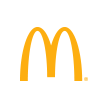
Our Growth Pillars

As the consumer landscape shifts, we are using our competitive advantages to further strengthen our brand.
Our growth pillars build on our strong foundations to ensure we can meet the moment today and have long-term success.

Maximize Our Marketing
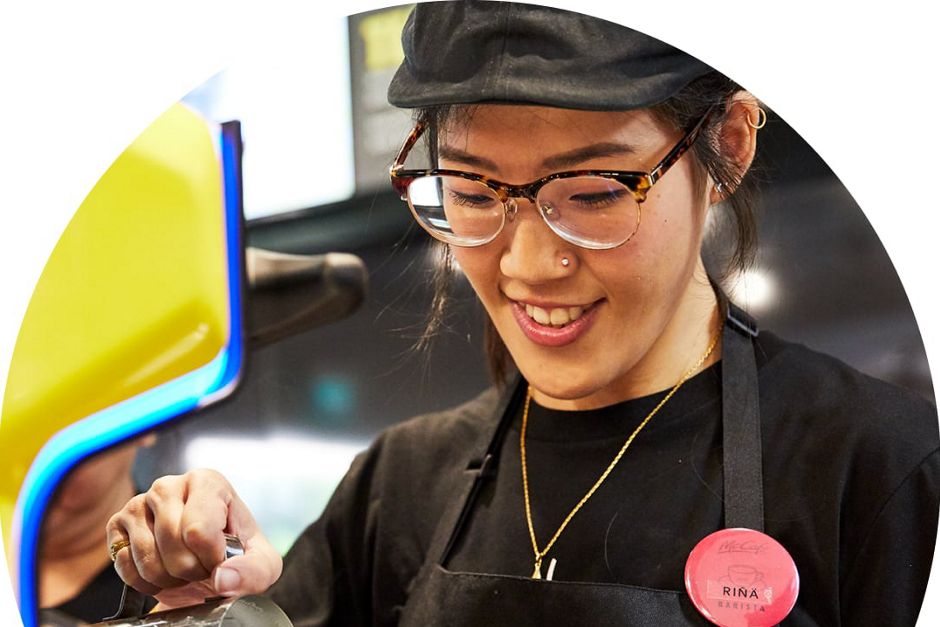
Commit to the Core
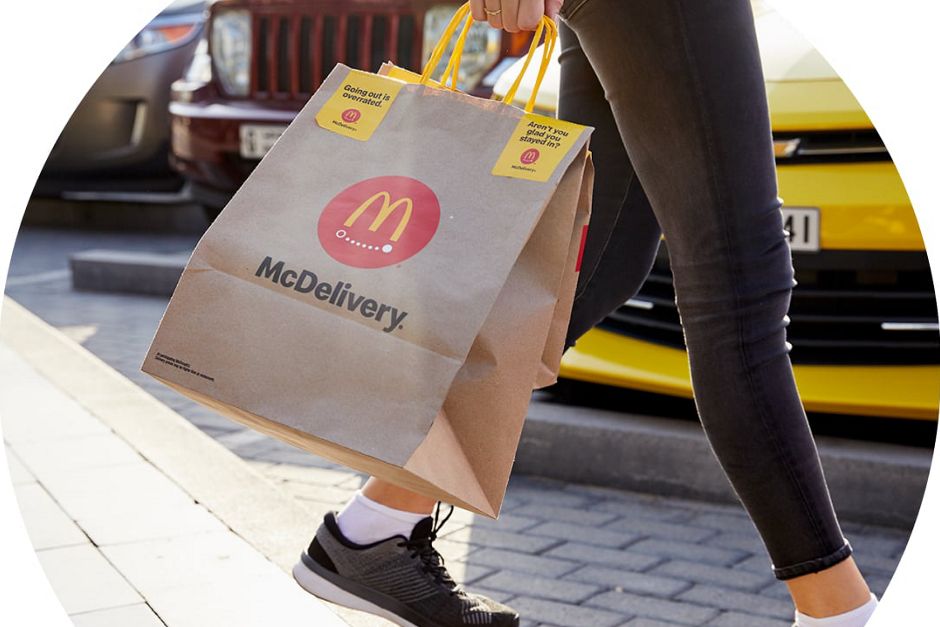
Double Down on the 4D’s

Consumers continue to prioritize brand trust, great taste and value as top reasons why they choose McDonald’s. As customers’ expectations are constantly shifting, we can build equity in our brand and trust by clearly articulating what we stand to do in the world: feed and foster communities.
Through our actions and communications, we will deliver on our purpose and mission and ignite our brand as a growth driver by taking a global, unified approach to building trust; creating a stronger connection to our customers to drive advocacy and continuing to offer great value and everyday affordability available to everyone.
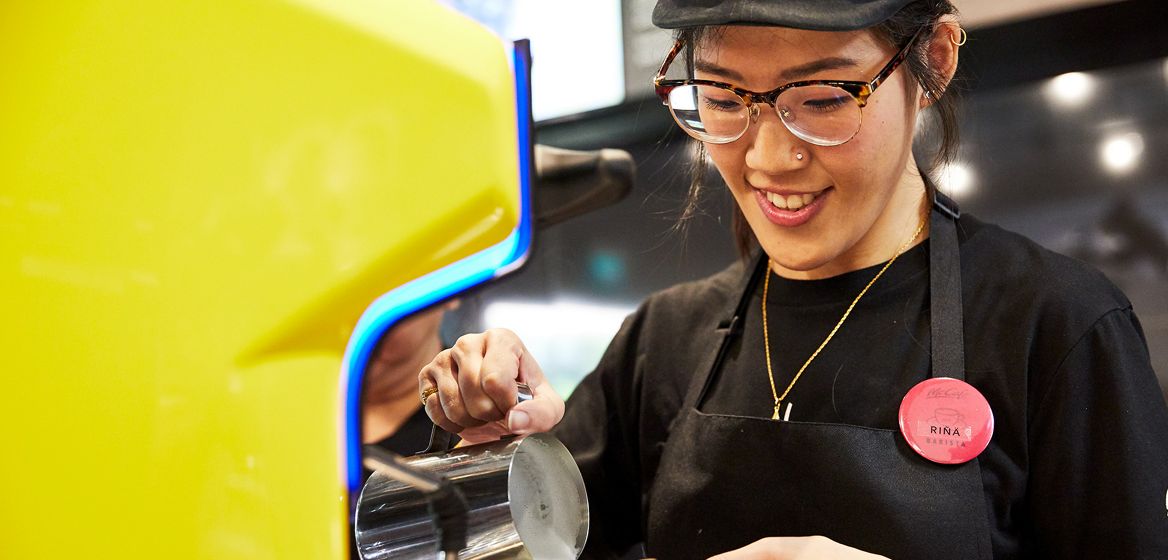
Our customers love our iconic food and our core customer favorites are about 70% of our sales. With expected growth in lunch and dinner occasions, we will focus on our two largest categories, beef and chicken. We will leverage our familiar favorites and create new ones to make our menu even more craveable. At the same time, we will use coffee to boost morning visits and build a foundation for future growth.
- We want to offer our customers the tastiest burgers in the QSR industry by making them hotter and juicier.
- We will offer our customers great-tasting chicken through McNuggets and McChicken, by expanding our spicy chicken sandwich options and developing a satiating large chicken sandwich.
- We will build McCafé brand awareness and deliver a consistently great coffee experience.
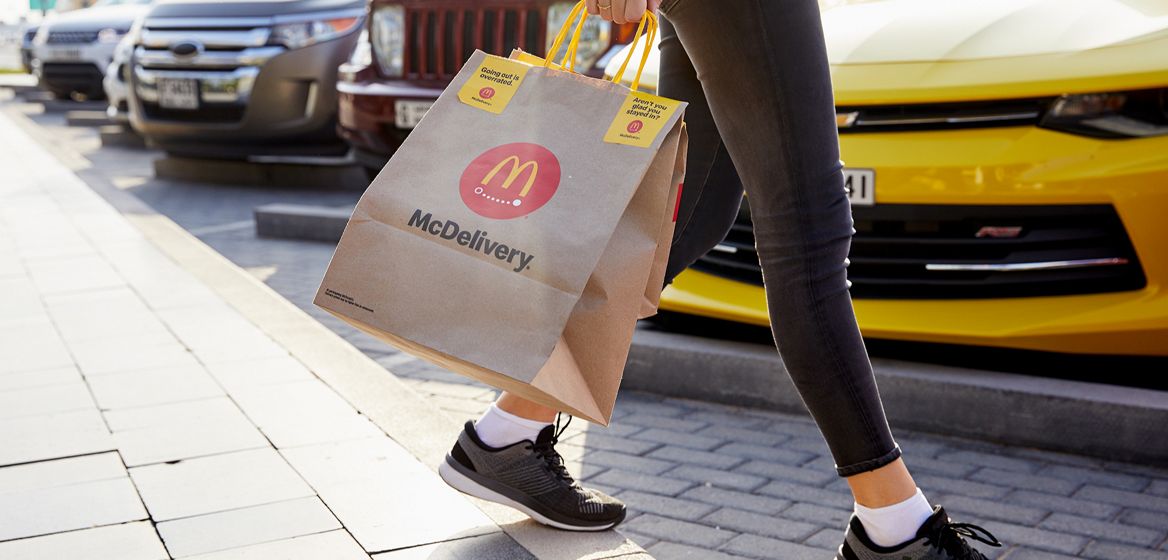
Double Down on the Four D’s
Consumers are increasingly choosing off-premise dining and we are adapting the McDonald's experience to meet their needs by doubling down on Digital, Delivery, Drive-Thru and Restaurant Development. Our vision is to position McDonald’s as the leading omni-channel restaurant in all our markets. We will make our customers’ experiences faster and easier through all of the ways they order and receive our delicious food.
- We are building on our digital foundation by enhancing our digital platform provide more personal, more convenient and better experiences for our customers. We’ll introduce MyMcDonald’s, a unified suite of compelling offerings that provide our customers multiple, complementary reasons to engage with us digitally, whether through mobile ordering, payments, delivery, rewards or deals.
- We aim to be the global leader in food delivery. We have a strong starting point and momentum in delivery and are prioritizing key actions to continue growth, including integrating delivery into our Global Mobile App.
- We will define the future of drive thru , an area where we already have a significant advantage as nearly 65% of our global restaurants have a drive thru. We plan to extend this leadership by continuing to make the customer experience even faster, testing new concepts and technology and having nearly all of new U.S. and IOM restaurants fully drive-thru enabled.
- Through a focus on restaurant development , we will accelerate the pace of our restaurant openings to fully capture the increased demand we have driven over the past few years. We see opportunity for further growth in many of our major markets and to explore new formats that show up under brand McDonald’s.
Latest Stories
More in who we are.
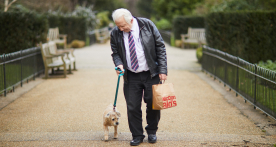
Our Mission & Values
Our purpose is to feed and foster communities, now more than ever.

Our History
How a small drive-in restaurant in San Bernadino grew into an American icon.

Our Leadership
We embrace the opportunity to lead by example and effect meaningful change.

The Latest Industry News & Insights
#e2 #l1 #eb5 #sba #investor #financial #franchise #hemp #startup
Franchise Business Plan – McDonald’s
- Business Plans , Commercial , Industry Insights
McDonald’s Franchise Business Plan
- 26 Sep, 2018
When writing a business plan for a McDonald’s franchise it is important to demonstrate the in-depth understanding of the franchise agreement as all McDonald’s restaurants must operate in line with the “McDonald’s System” , a concept of restaurant operations that includes, among others, rights in trademarks, manuals, and other confidential business information, and operational, real estate, and marketing information. According to IBISWorld , McDonald’s has 37,000 restaurants in over 100 countries , out of which more than 90% are operated by franchisees , the remainder being company-operated stores.
When drafting a business plan for a McDonald’s restaurant, there are several issues to address:
Initial Investment
Generally, no financing arrangements are offered by McDonald’s. The company allows franchisees to open a new restaurant or purchase an existing one. The cost of opening a new restaurant generally includes a $45,000 fee, a down payment of 40% of the total costs of a new restaurant, and the average equipment and pre-opening costs of $1,611,040. The cost of purchasing an existing restaurant includes the price of an existing restaurant which varies on a wide range of factors such as sales volume and profitability and a minimum of 25% cash down payment. Joorney Business Plans has experience in creating long-term financial projections for McDonald’s restaurants and understands the specifics pertaining to the initial investment requirements.
The company selects the site for the location of a restaurant and negotiates the location’s purchase or lease. The choice of location is based on a variety of factors such as population density, traffic patterns, and competition. However, as McDonald’s cannot guarantee that the economic and demographic factors at a specific restaurant location will remain constant, Joorney Business Plans develops in-depth local market analyses with the expected local economic and demographic trends.
Regulations
A McDonald’s restaurant is required to comply with various local, state, and federal laws, including health and sanitation laws and menu-labeling requirements. Joorney Business Plan Writers have experience helping McDonald’s franchisees create a timeline of activities, including obtaining licenses, with a particular focus on the initial year, as per requirements of the investors and immigration services.
All McDonald’s franchisees must complete a training program successfully before signing the franchise agreement. McDonald’s bears the cost of maintaining the Hamburger University and other training centers and provides instruction for the operation of a franchise restaurant. However, a franchisee must cover all traveling, living, and compensation expenses related to employee training. Joorney Business Plans has experience describing and developing employee plans and linking the proposed individuals’ knowledge and training to their designated roles.
If you are lucky enough to be selected as a McDonald’s franchisee, it is the opportunity of a lifetime . You get guaranteed return on investment due to their gigantic historical performance numbers and internationally recognized brand and not many franchises can compete with that.

EB-2 NIW for Pilots: Yes or No – Let the Debate Begin!

Navigating Visa Programs with Visa Franchise: The Key to Unlocking Franchise Opportunities

What Is an Expert Opinion Letter for the EB-2 NIW Visa?

Navigating Visa Programs with Visa Franchise: The Key to ...

Webinar Recap — Marketing Success for Immigration Lawyers...

Marketing Success for Immigration Lawyers: Expert Tips fo...

Joorney at the 2024 Small Business Expo – Miami

Webinar Recap — Pathways towards the EB2-NIW for Informat...

Pathways towards the EB2-NIW for Information Technology (...
In the press:.

- Immigration
- Testimonials
- Start-up Advisory
- M&A Advisory
- Pro Bono Work
- Premium Market Research
- Joorney Digital
- Partner Program
- Joorney Blog
- Ask the Joorney Expert
We Offer Services. Built On Trust
1-844 (566-7639) CALL US

Miami 1688 Meridian Ave Ste 700 Miami Beach, FL 33139
Canada 1200 McGill College Avenue Suite 1100, Montreal, QC, H3B4G7
France 11 rue de Rouvray 92200 Neuilly sur Seine
Serbia Bulevar Kralja Aleksandra 28 Floor 2, 11000 Belgrade
Australia Unit A1 / 35-39 Bourke Road, Alexandria NSW 2015
Immigration | Commercial | Start-Up Advisory | M&A Advisory |
Copyright © 2024 Joorney. All rights reserved. | Privacy Policy
- First Name *
- Last Name *
- Email Address *
- Country Code *
- Phone Number *
- How did you hear about us? * How did you hear about us? (Required) Immigration Attorney Friend Google Ads Google Search Webinar Tradeshow French Founders AILA FACC Consultant Real Estate Agent Accountant/CPA Business Broker LinkedIn Facebook BBB Other
- What is the attorney's name?
- What is the tradeshows name?
- What is the consultant name?
- What is the real estate agent name?
- What is the accountant/CPA name?
- What is the business broker name?
- Company Name
- Do you have a website? (Optional) Do you have a website? (Optional) Yes, I do. No, I don't.
- What is your website address? (Optional)
- Would you like help building a website for your business? (Optional) Would you like help building a website for your business? (Optional) Yes, please! No, thank you.
- When would you expect to need to start these services? (Optional) How soon would you like to be contacted about building a website? (Optional) ASAP! Once I start my business plan. After my business plan is finalized. After my visa is approved. I'll reach out when I'm ready.
- Other Industry
- How Do you Prefer To Be Contacted? * How Do you Prefer To Be Contacted? (Required) Phone Zoom Whatsapp Skype Wechat
- What Language Do You Prefer To Speak? (Optional) What Language Do You Prefer To Speak? (Optional) English Spanish Portuguese French Chinese Russian Other
- Other Language
- I am....(Required) * I am....(Required) Applying For A Visa An Immigration Attorney A Start-Up An Established Business An M&A Firm A Business Broker Other
- Select A Business Stage (Optional) Select A Business Stage (Optional) Idea Pre-revenue Post-revenue I'm not sure
- What Is Your Average Deal Size (Optional) What Is Your Average Deal Size (Optional) Under $1M $1-10M $10-20M Over $20M
- What Service Are You Interested In? - ALL (Required) * What Service Are You Interested In? (Required) Immigration Business Plan SBA/Bank Loan Business Plan Franchise Business Plan Grant Business Plan Landlord Deck Market Research Marketing & Sales Plan Financial Model Investor Business Plan Pitch Deck Feasibility Study Idea Selection Capital Raise Strategic Business Plan Debt Financing Confidential Information Memorandum (CIM) Executive Summary Teaser Other
- What Service Are You Interested In? - Startup (Required) * What Service Are You Interested In? (Required) SBA/Bank Loan Business Plan Grant Business Plan Market Research Marketing & Sales Plan Financial Model Investor Business Plan Pitch Deck Feasibility Study Idea Selection Capital Raise Strategic Business Plan Debt Financing Executive Summary Teaser
- What Service Are You Interested In? - M&A Advisor & Business Broker (Required) * What Service Are You Interested In? (Required) Confidential Information Memorandum (CIM) Executive Summary Teaser
- What Service Are You Interested In? - Established Business What Service Are You Interested In? (Required) SBA/Bank Loan Business Plan Franchise Business Plan Grant Business Plan Landlord Deck Market Research Marketing & Sales Plan Financial Model Investor Business Plan Pitch Deck Feasibility Study Idea Selection Capital Raise Strategic Business Plan Debt Financing Executive Summary Teaser
- Other Service
- Visa Type? * What Immigration Business Plan Visa Type Do You Need? (Required) E2 L1 EB2 NIW EB5 Direct EB-5 Regional Center H1B O1 EB1A EB1C Canada I am not sure
- Are you the Visa Applicant? Are you the Visa Applicant? (Optional) Yes, I am the visa applicant No, I'm not the visa applicant
- What is your relationship to the visa applicant? What is your relationship to the visa applicant? (Optional) Family Friend Attorney Other
- Other relationship
- Is this a New Application, RFE, Renewal or Denial? Is this a New Application, RFE, Renewal or Denial? (Optional) New Visa Application RFE Renewal Denial I don't know
- Do you have a deadline? * Do you have a visa application deadline? (Optional) Yes, I have a deadline No, I don't have a deadline
- By When? MM slash DD slash YYYY
- Details/Notes?
- Google Re-Captcaha
- Name This field is for validation purposes and should be left unchanged.

- E2 Visa Business Plan
- Pitch Decks
- Market Research
- Share full article
Advertisement
Supported by
McDonald's in Moscow: A 'Bolshoi Mak'
By Felicity Barringer, Special To the New York Times
- April 30, 1988
The prospect of golden arches on Gorky Street moved a step closer today when the McDonald's Corporation agreed to help put two all-beef patties, special sauce, lettuce, cheese, pickles and onions on a Soviet bun.
The Big Mac will be sold in its original form at 20 McDonald's restaurants in Moscow and will be known as the Bolshoi Mak (bolshoi means big in Russian).
A joint-venture agreement to open the restaurants and a huge food-processing plant to service them was announced today by the company's subsidiary, McDonald's Restaurants of Canada, and the food-services division of the Moscow City Council.
The restaurants will be staffed by Soviet workers, McDonald's said, and run by Soviet managers trained in McDonald's traditions, perhaps at the company's ''hamburger universities'' in Illinois, London, Munich and Toronto.
McDonald's first restaurant is not expected to open before the fall. It will have 650 seats, and George A. Cohon, the president of the Canadian subsidiary, said, ''We think this will be the highest-volume McDonald's in the world.''
The Bolshoi Mak will sell for 2 rubles (about $3.38), or approximately 1 percent of the average Soviet monthly salary. (In the United States, the average Big Mac costs $1.45.) ''The Big Mac will taste the same'' as it does anywhere else in the world, Mr. Cohon promised at a news conference in the City Council offices.
Mr. Cohon first met with Soviet officials at the Olympic Games in Montreal in 1976, a McDonald's spokesman said, and negotiations leading to today's announcement have been going on for more than 10 years. The pace quickened after Mikhail S. Gorbachev became the Soviet leader.
Because Mr. Cohon took the lead role, the deal was made through the Canadian subsidiary, McDonald's said. Questions About Supplies
For skeptics who suspect that the promise of getting a happy meal on the run in Moscow - or the promise of McDonald's receiving a steady supply of meat, potatoes and cheese - might be a whopper, Mr. Cohon offered assurances that ''our specialists have visited many facilities to be sure that the comparable products exist.''
He added, ''We wanted to use the local product whenever possible.''
However, a spokesman for the Moscow City Council, Valery A. Zharov, admitted, ''We will face some problem in obtaining some supplies for the central processing center.''
He added, ''McDonald's has very strict requirements.''
The golden arches near Red Square would not be the first in a Communist country. A McDonald's opened in Belgrade, Yugoslavia, earlier this year; another is expected to open in Budapest this month.
Moscow dramatically signaled its interest in McDonald's in November 1986, when Soviet television carried a flattering portrait of a McDonald's restaurant. Viewers were shown hamburgers sizzling on the grill as the staff hustled behind the counter, filling orders. A commentator observed, ''Maybe there is something we can learn from this.''
The first McDonald's in Moscow will open on Gorky Street, near the City Council's offices and not far from the site where Moscow's first Pizza Hut restaurant is expected to open late this year or early in 1989.
The second McDonald's to open, at an undisclosed location, will sell warm burgers for cold hard Western currency.
Mr. Cohon and his Soviet partners would not say how much money McDonald's would invest in the project. The bulk of the initial investment will be put into the construction of a ''commissary,'' or processing plant, in Moscow.
Envisaged as a 100,000-square-foot complex operating at an as-yet-unchosen location, this commissary would have several production lines - one for potatoes, one for meat, one for sauce - as well as a bun bakery, a pie bakery, freezing operations and a distribution center.
This plant would supply all 20 restaurants, the agreement said. McDonald's Owns 49 Percent
Established under the Soviet law on joint ventures adopted last year, the McDonald's venture is 51 percent owned by the Soviet partner and 49 percent by McDonald's. The law guarantees the Western partners the opportunity to repatriate their profits, an essential feature because the Soviet ruble is not convertible into Western currencies at the official exchange rate. One problem the venture faces is packaging. ''That's going to be rough,'' Mr. Cohon said. He said that plastic and paper packaging might be imported from Yugoslavia.
''The important thing for us,'' he added, ''is opening the restaurant, being sure queues are kept to a minimum, being sure that service is proper, the sandwich is warm and the premises are clean.''
Explore Our Business Coverage
Dive deeper into the people, issues and trends shaping the world of business..
Ghost Kitchens Are Disappearing: Delivery-only operations boomed during the pandemic. Now Wendy’s, Kroger’s and mom-and-pop food businesses are rethinking their operations.
Axios Shifts Its Strategy: Jim VandeHei, the chief executive of Axios, is becoming one of the first news executives to adjust their company’s strategy because of A.I.
The Worst Part of a Wall Street Career: A.I. tools can replace much of Wall Street’s entry-level white-collar work , raising tough questions about the future of finance.
Combining Business and Leisure Travel: As employees increasingly add leisure time to their business trips , companies are trying to figure out where their duty of care obligations begin and end.
Inside Executive Protection Jobs: Here’s how three women trained to work in jobs protecting prominent families and ultra-high-net-worth individuals.
Gen X-ers Inch Toward Retirement: The oldest members of Generation X are several years from stopping work , but some are already seeking homes that will suit their later years.
The first McDonald’s in Moscow that drove the city mad, 1990

On January 31, 1990, the first Soviet McDonald’s opened in Moscow. The first McDonald’s ever in Soviet Union.
Nowadays it’s hard to believe that thousands of people would be willing to stand out in the cold for hours just to try a McDonald’s hamburger. But when the first McDonald’s arrived in Moscow in 1990, the whole city went mad.
The Moscow McDonald’s initiative was a joint venture between McDonald’s of Canada and the Moscow city council. A plan first envisioned when George Cohon, founder, and CEO of McDonald’s Canada, met Soviet Union officials at the ’76 Summer Olympics in Montreal. And almost a quarter of a century later, on January 31st, 1990 it became a reality.
The Russian capital’s inaugural McDonald’s set the record for most customers on its first day of opening by serving over 30,000 hungry punters. Budapest’s main branch of McDonald’s previously held the record, with 9,100 clients.
Thousands of Muscovites flocked to the new burger joint, forming lines several kilometers long in the center of Moscow on Pushkinskaya Square. The crowds of people were so huge that scores of policemen were sent to control the commotion, much like security at rowdy football matches.
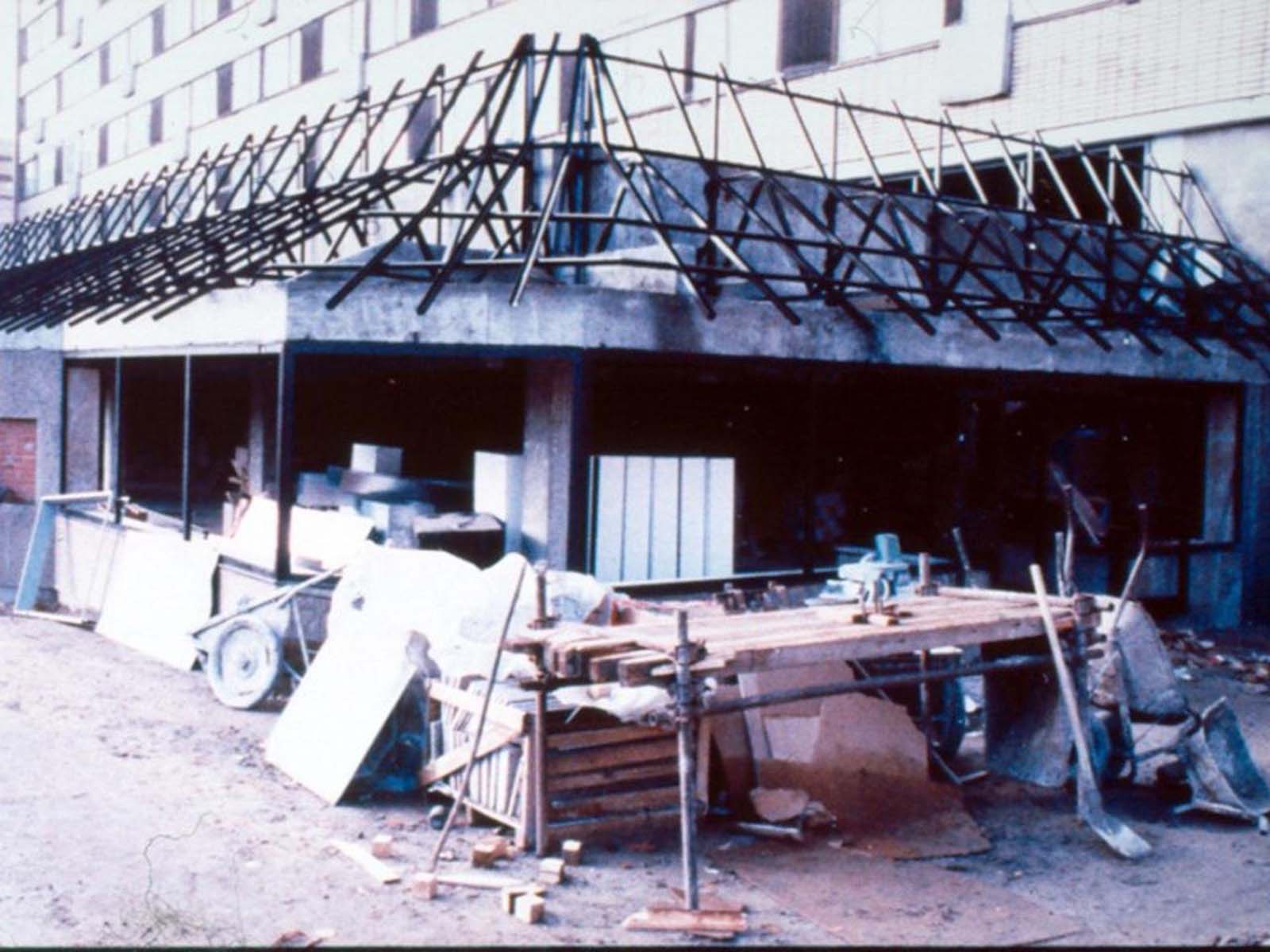
It was the largest McDonald’s in the world at the time of its construction.
At the time of its construction, it was the largest McDonald’s restaurant in the world. A venue with 900 seats with a staff of about 600 workers that were carefully selected from 35,000 applicants.
As a result, the first workers were the crème de la crème of Soviet youth: students from prestigious universities who could speak foreign languages with brilliant customer service skills were hired.
This new workforce was a sharp contrast to the typical Soviet service sector, known for being dismissive, unsmiling, and cold. Soviet people were so accustomed to rude, boorish service that when they were faced with the polite manners and beaming faces they were completely shocked. In fact, the customers felt so uneasy while being served by someone who was smiling that the McDonald’s chiefs asked their employees to smile less.
For the ordinary Soviet citizen during perestroika, McDonald’s offered a glimpse of what life (and eating out) was like over the Iron Curtain. People from Soviet Union heard so much about western culture without being able to get near it, so Soviet citizens really went mad when the golden arches rocked up in Moscow.
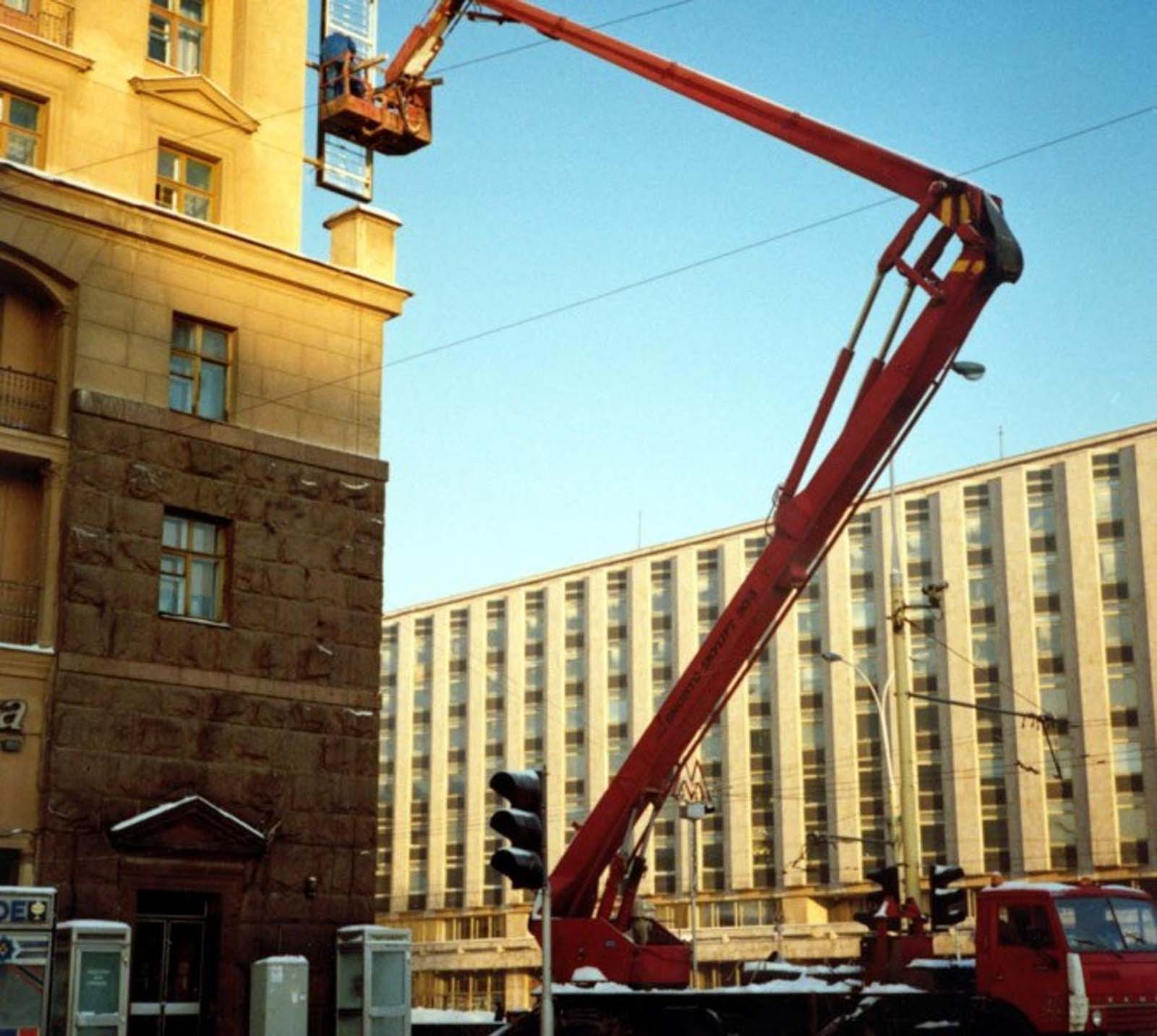
And a venue with 900 seats needed a lot of employees, too.
However, McDonald’s was not cheap in those days. In a country where the average salary was about 150 rubles per month, a Big “Mak” was selling for 3.75 rubles. One Big Mac cost the equivalent of a monthly bus/metro pass.
The summer came, but the lines just kept growing. People from other cities were flocking the McDonald’s restaurant just for a single hamburger. “We stood under the melting sun for around eight hours,” photographer Mitya Kushelevich recalled. “That wasn’t so much of a problem as we were used to standing in lines for days just to get our monthly ration of sugar and tea.”
“Once inside we were blown away by the number of young cashiers behind the huge counter, smiling, moving like bees, serving one meal after another.
Nothing like our fat old ladies in white gowns sitting in front of empty shelves, pyramids of dusty canned food as window dressing.” “I still remember how insanely huge the milkshake looked and I didn’t know how to hold a Big Mac with my tiny hands.”
In 1991 and 1992, long lines could still be seen and people had to wait for hours to enter. The crowds outside the Moscow restaurant did eventually die down a little from Jan. 31,1990, when more McDonald’s were opened in Russia.
The unveiling of the next McDonald’s restaurants were also considered big historic moments. The opening ceremony of the second restaurant in 1993 was even attended by President Boris Yeltsin.

In a country where unemployment did not exist, 35,000 people applied for a job in the fast food restaurant.

Around 600 were hired.
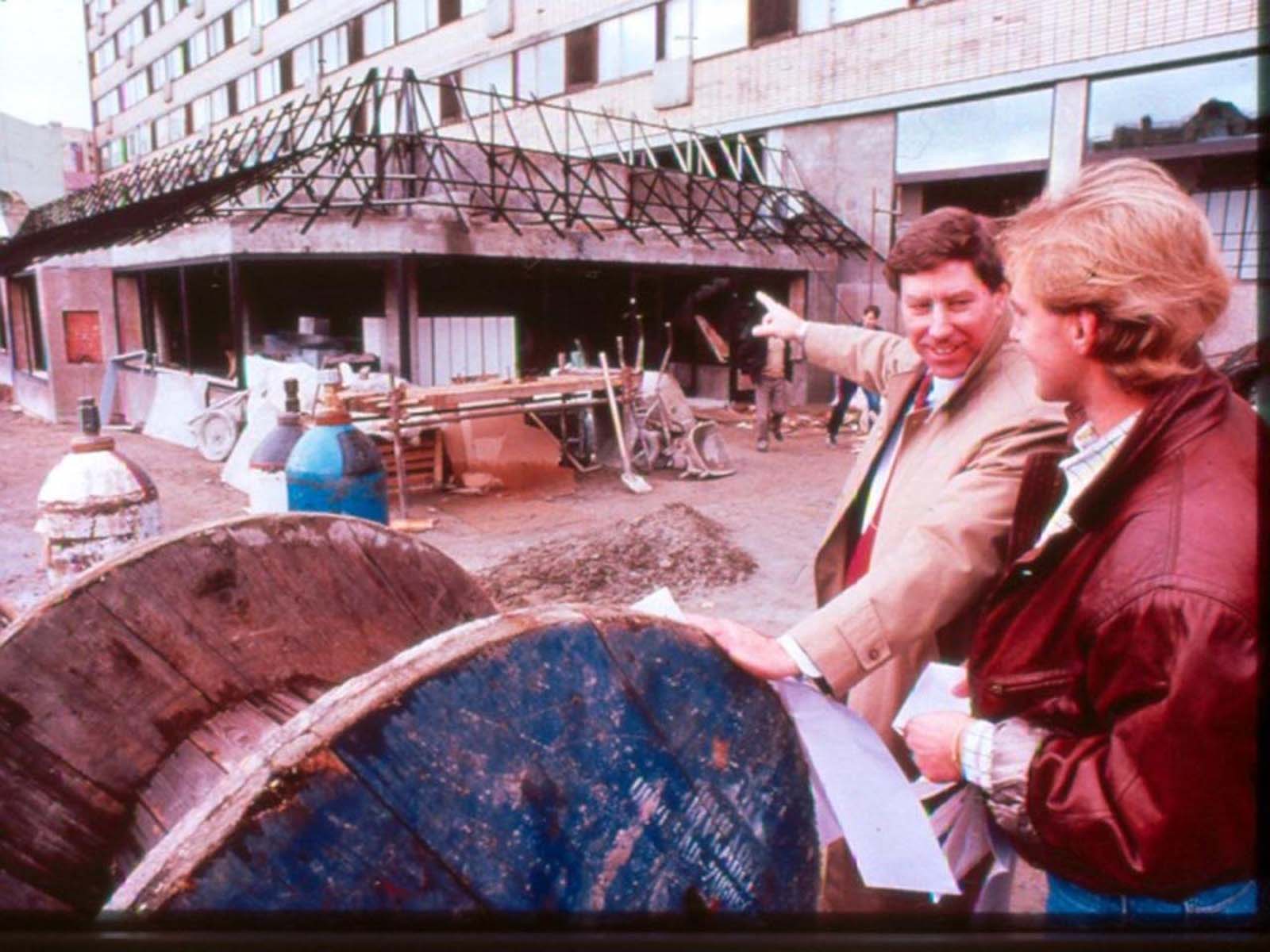
The venture had been in talks with the Soviet officials since 1976.

And you could say that the appearance of this notorious symbol of capitalism was a sign that times were changing.
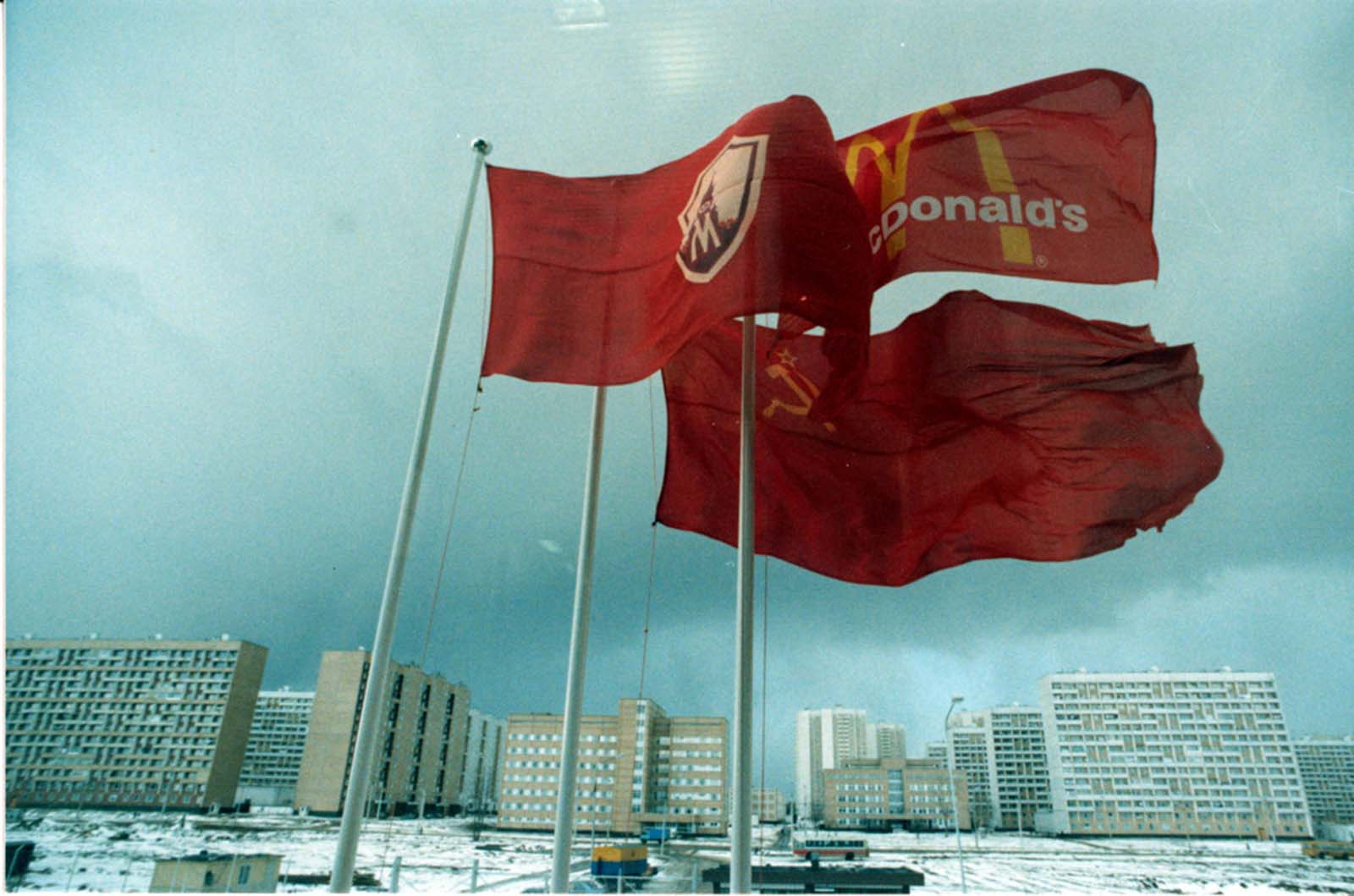
Reportedly, the restaurant expected to serve around 1,000 during its first day, but more than 5,000 Russians lined up in Pushkinskaya Square before it even opened.
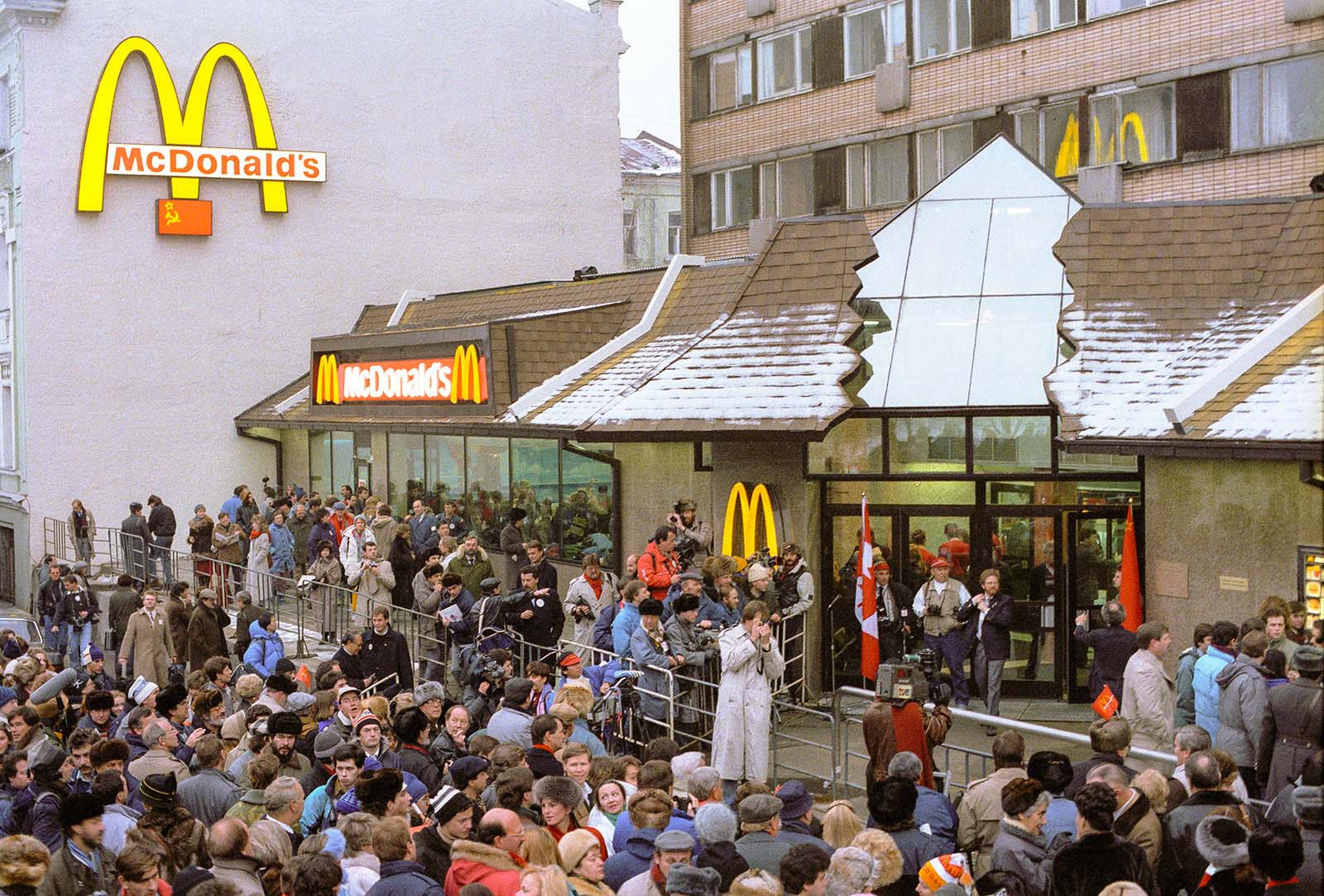
One Big Mac cost the equivalent of a monthly bus/metro pass.

The summer came but the lines just kept growing. People from other cities were flocking the restaurant just for a single hamburger.

“We stood under the melting sun for around eight hours,” one visitor said.
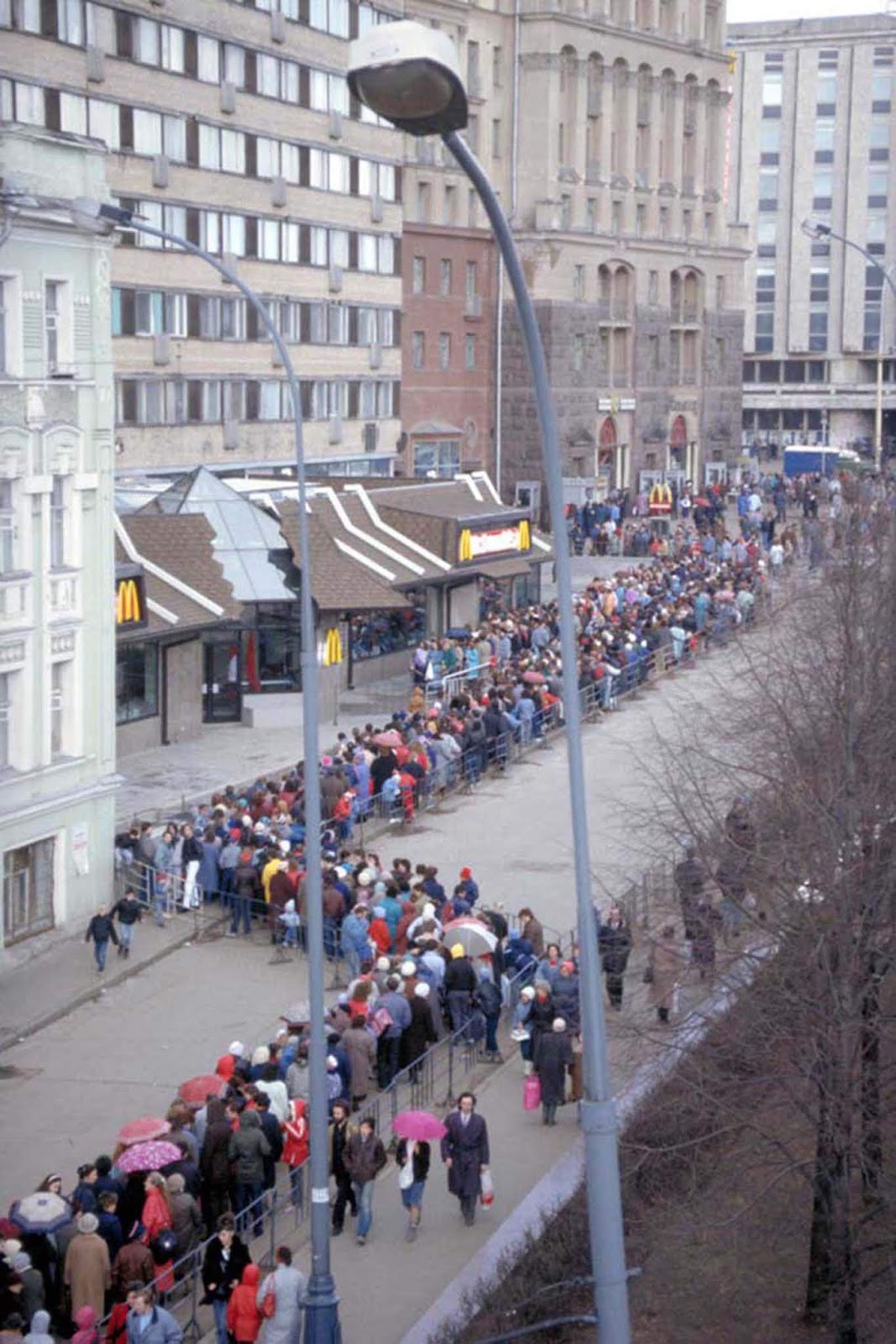
“That wasn’t so much of a problem as we were used to standing in lines for days just to get our monthly ration of sugar and tea”.

“Once inside we were blown away by the number of young cashiers behind the huge counter, smiling, moving like bees, serving one meal after another”.
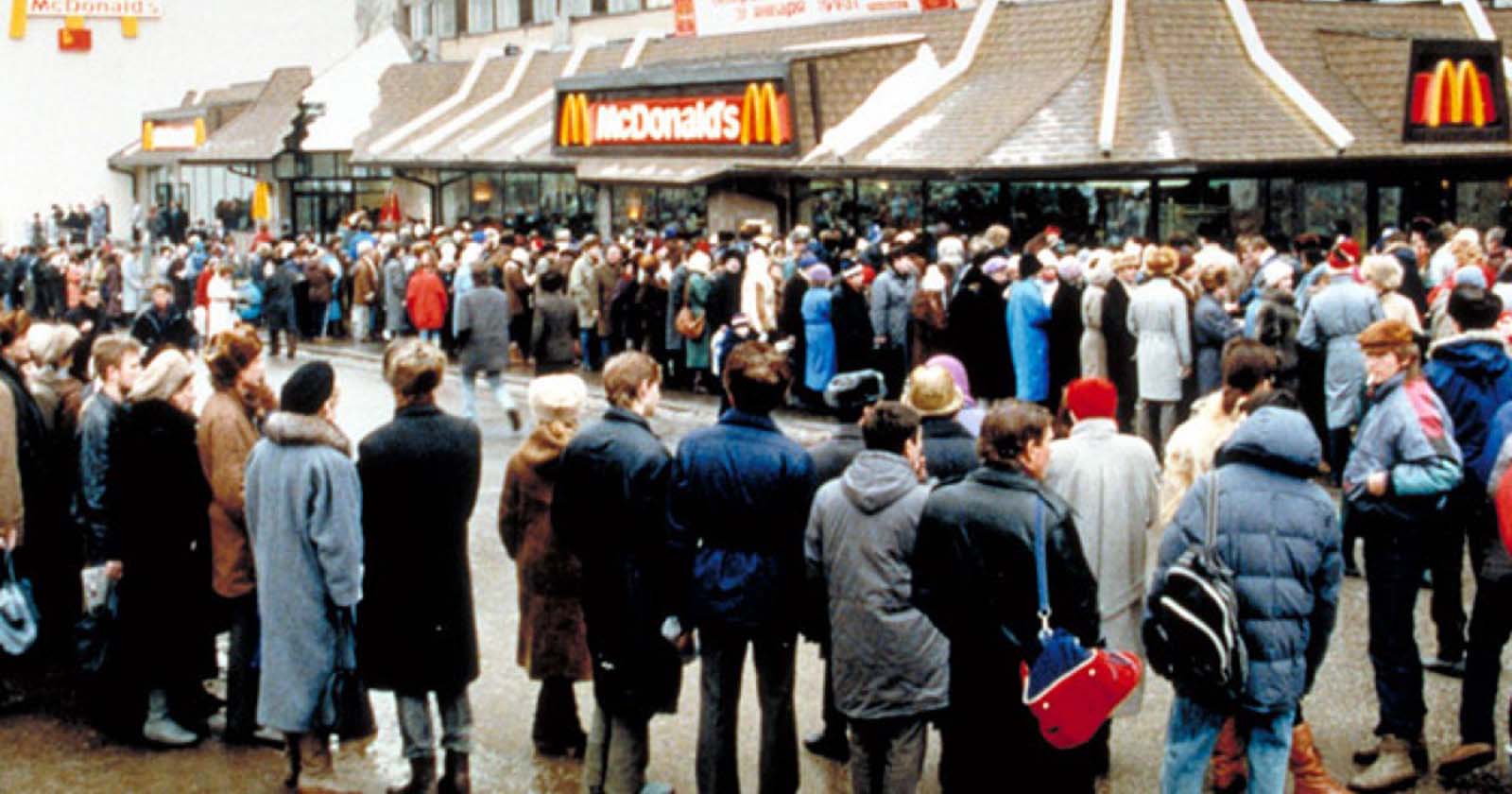
“Nothing like our fat old ladies in white gowns sitting in front of empty shelves, pyramids of dusty canned food as window dressing”.
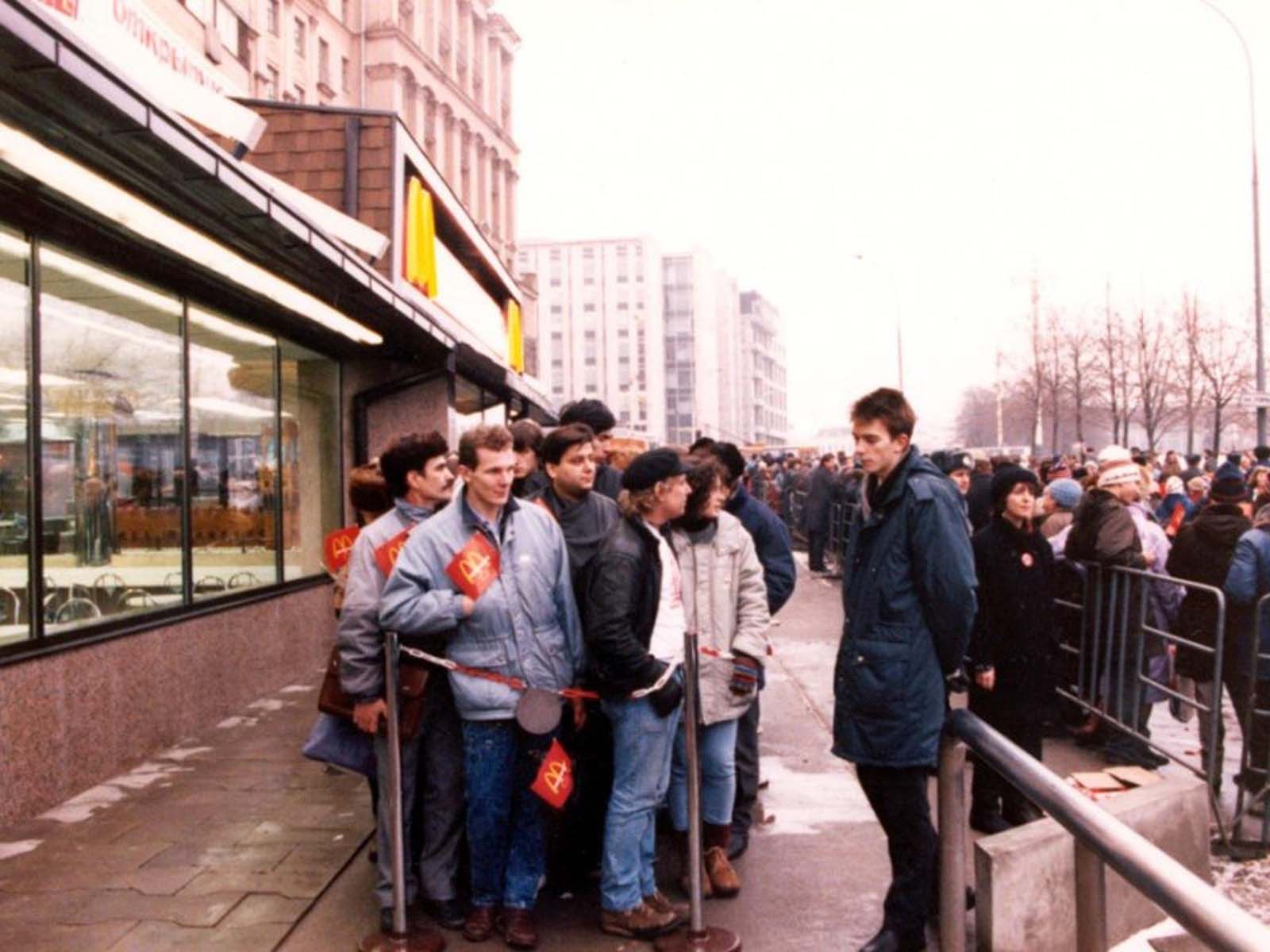
“I still remember how insanely huge the milkshake looked and I didn’t know how to hold a Big Mac with my tiny hands”.

The Moscow McDonald’s initiative was a joint venture between McDonald’s of Canada and Moscow city council.

A plan first envisioned when George Cohon, founder and CEO of McDonald’s Canada, met Soviet officials at the ’76 Summer Olympics in Montreal.
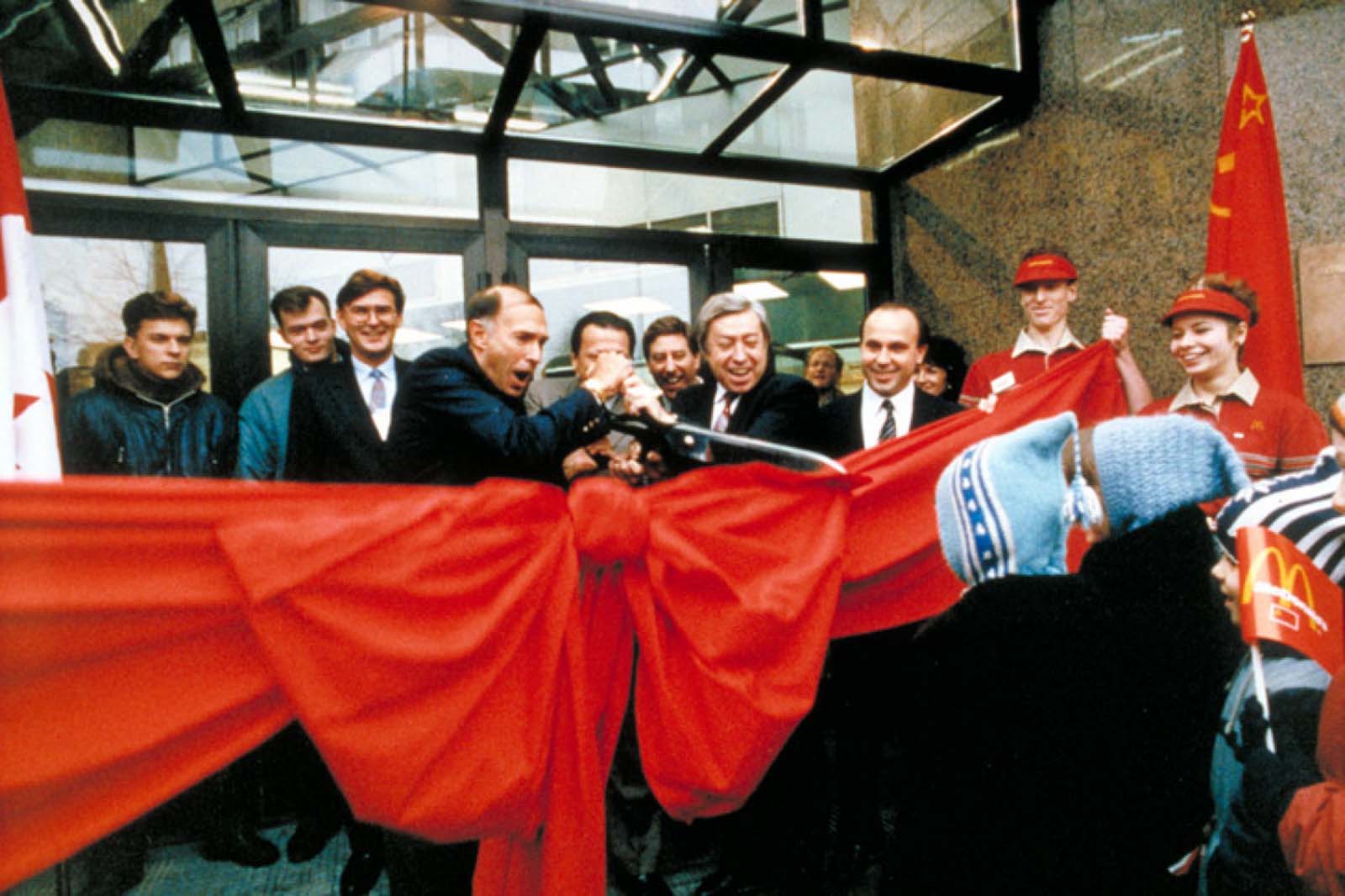
“I’m particularly proud of the people story behind the first opening, both from Canada and Russia, learning from each other and working as one team”.
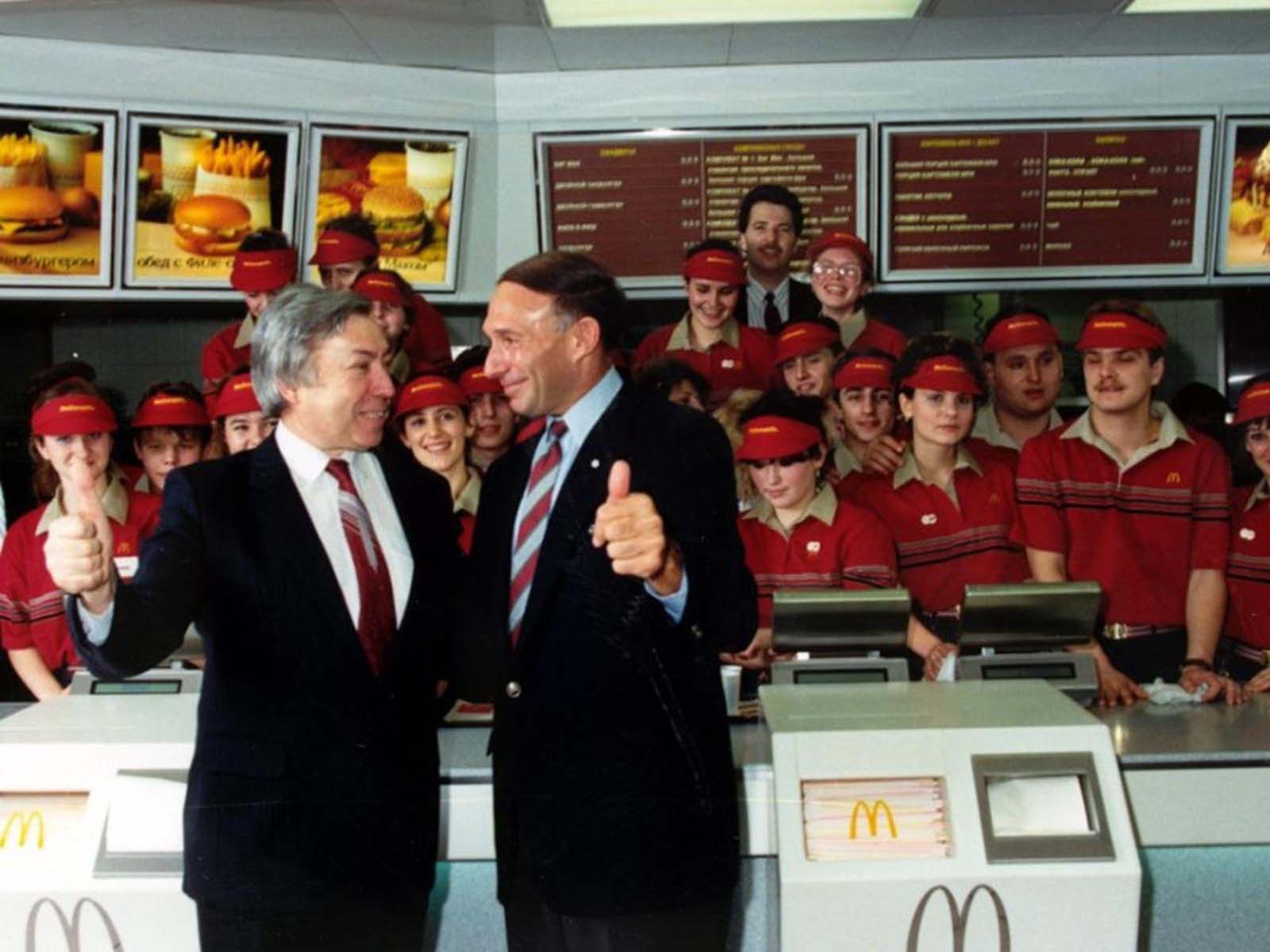
“This is a story about co-operation between nations”.
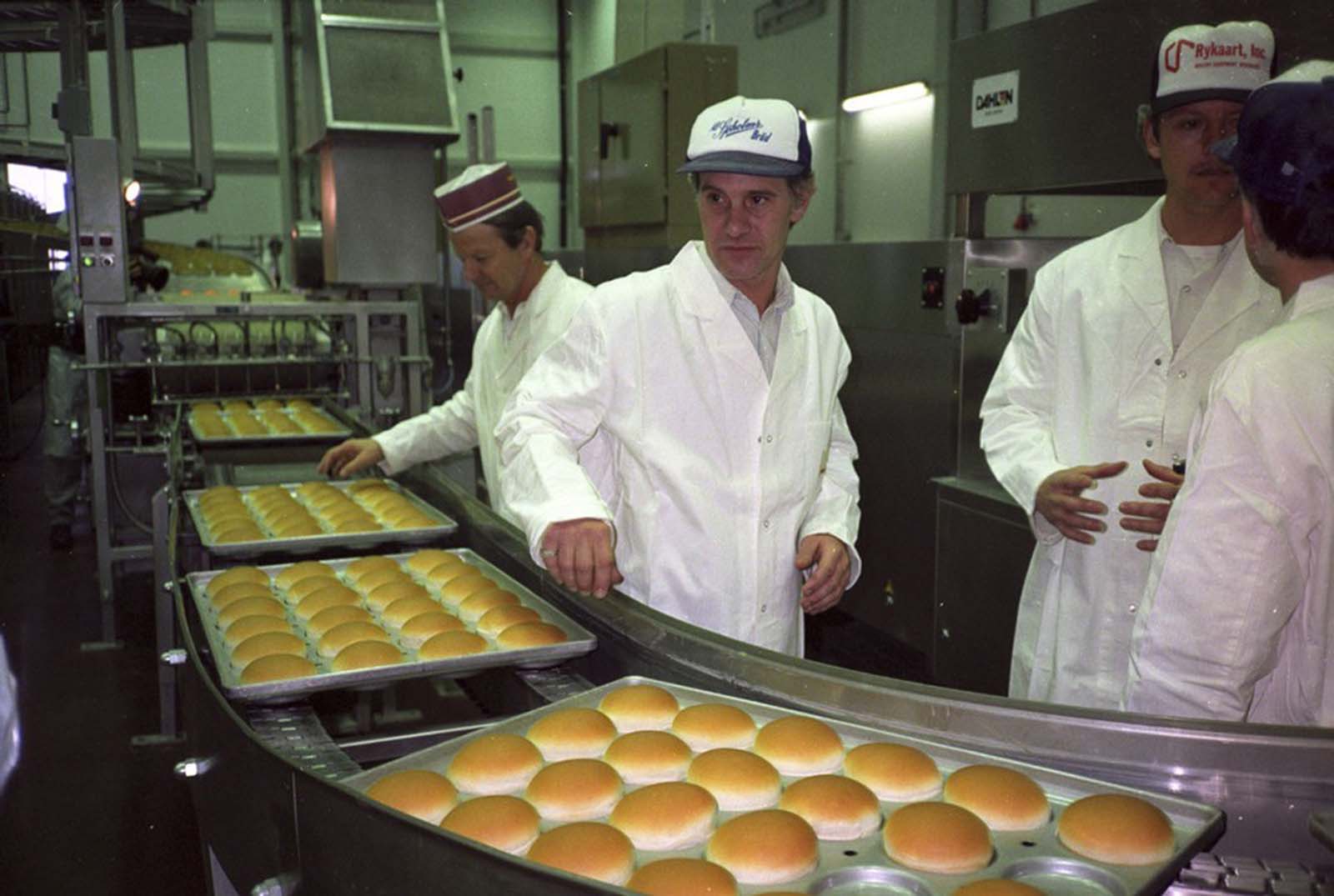
“And it is also a story about the Soviet who saw a sign outside reading ‘Rubles Only’ – and who said to me, ‘This is my restaurant’”.
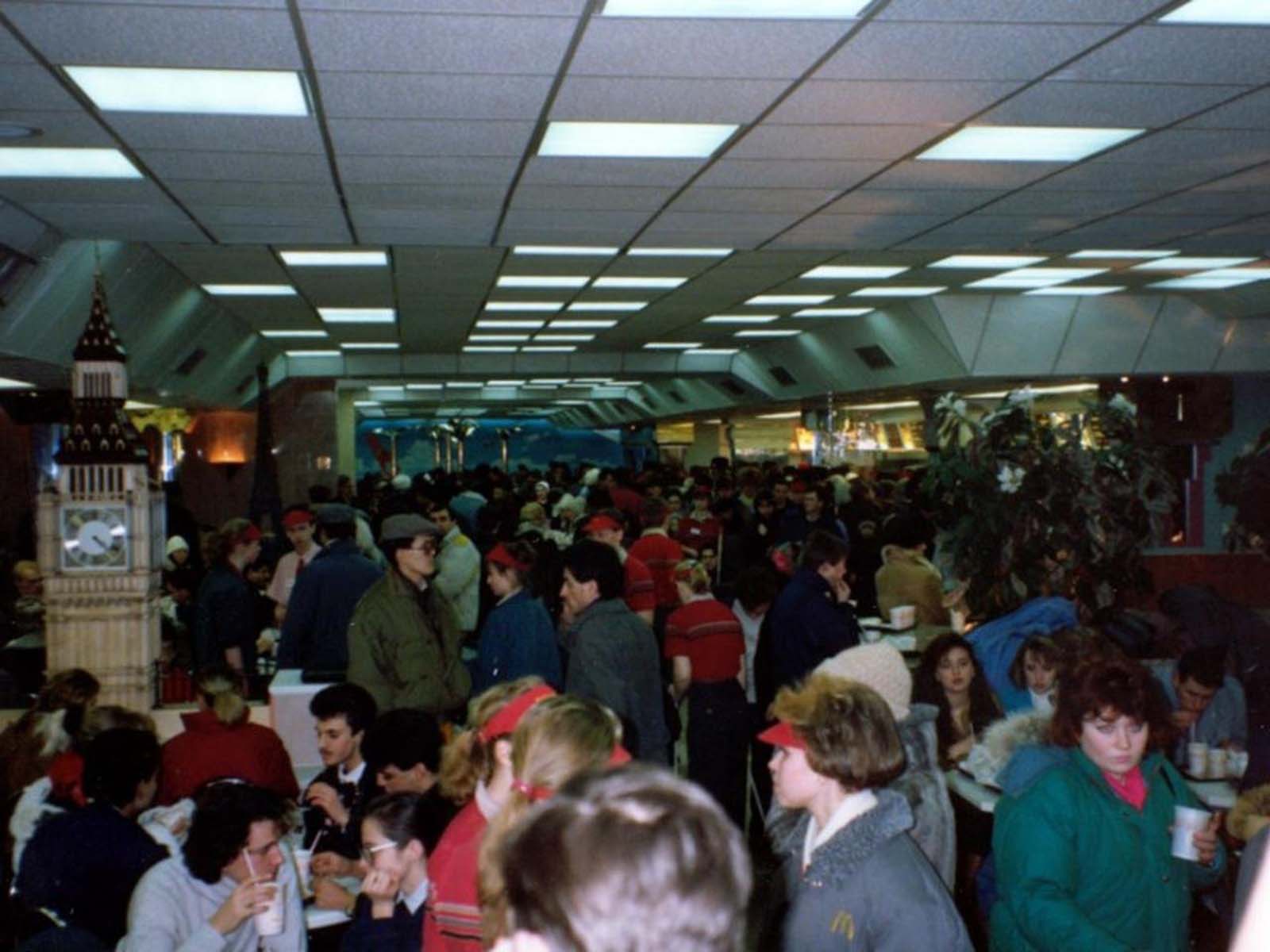
The opening drew many important people.

The opening ceremony of the second restaurant in 1993 was even attended by President Boris Yeltsin.

Waiving the capitalism “flag”.

Huge crowd lined up outside the first McDonald’s in Moscow.
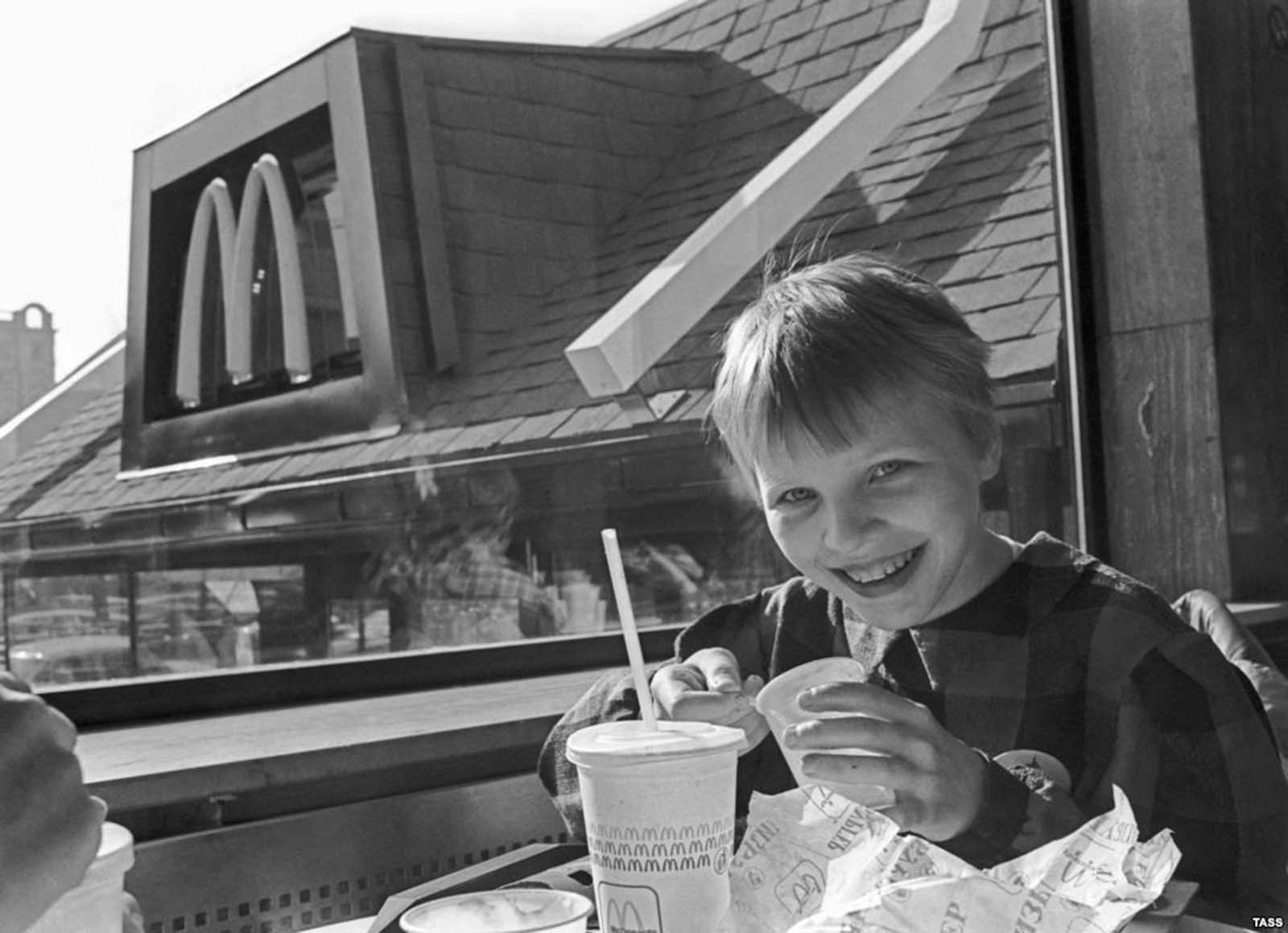
And people couldn’t get enough.

In total, over 30,000 customers passed through the doors on the opening day of the restaurant.
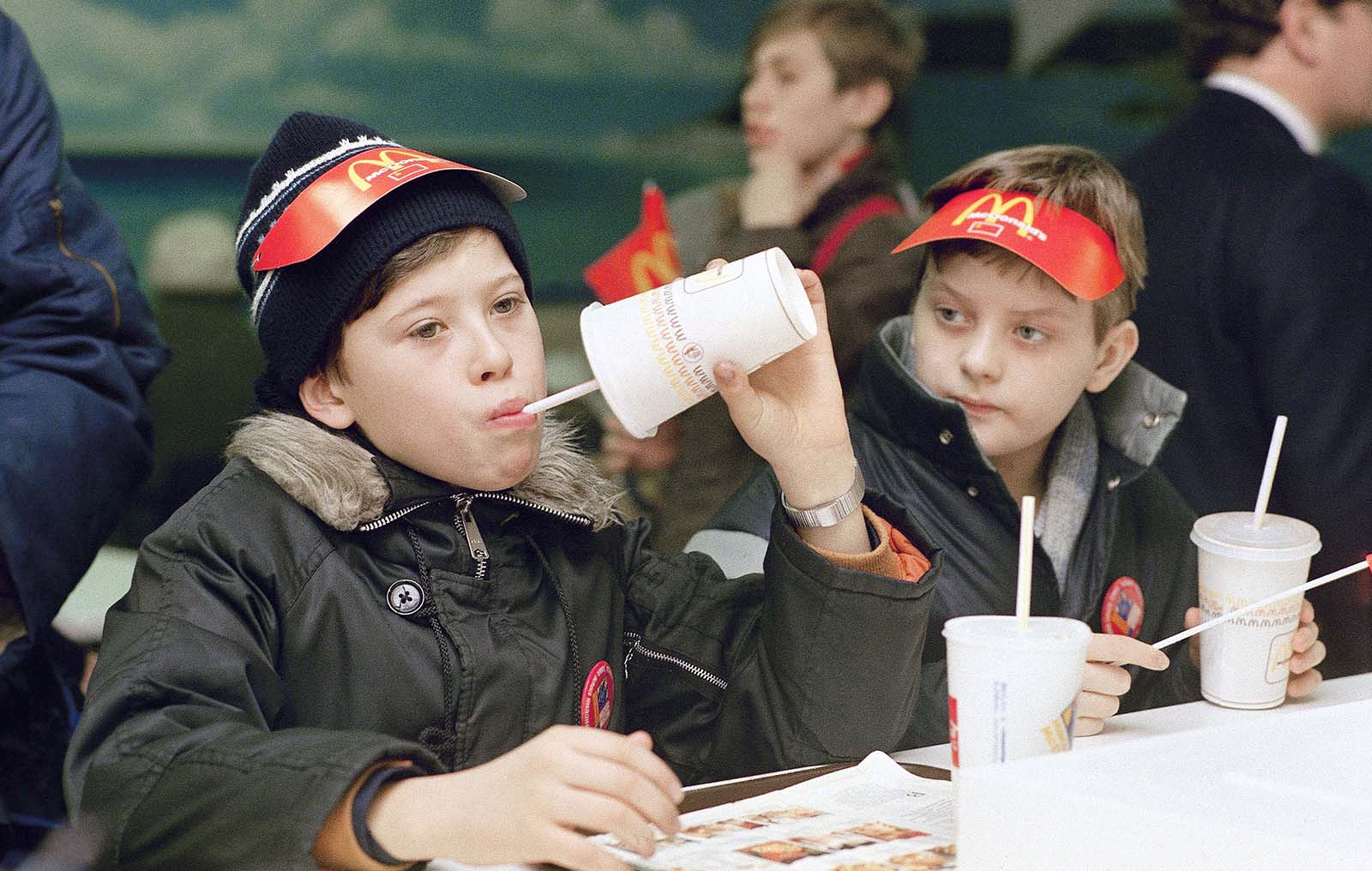
Setting a record for the number of customers served by a single McDonald’s in a day.

An old lady enjoyed her burger.

The Soviet Union dissolved on December 26, 1991.
(Photo credit: Sputnik).
Updated on: November 20, 2021
Any factual error or typo? Let us know.

IMAGES
VIDEO
COMMENTS
A brief history of McDonald's: Launched in 1948, Speedee Service System was the forerunner of McDonald's. It was launched by the two McDonald's brothers, who adopted the drive-in and franchising concept for fast-food delivery. Their first franchise agent was Ray Kroc, who opened the first McDonald's franchise back in 1955.He bought the rights to their business for US$ 2.7 million in ...
Introduction. Starting a fast-food empire like McDonald's requires careful planning and a solid business plan. In this comprehensive guide, we will walk you through the essential steps of creating a McDonald's business plan, covering market analysis, menu development, marketing strategies, operational structure, and financial projections.
McDonald's business model centers on a master plan, titled "Plan To Win," which is implemented across the globe. According to McDonald's mission statement, "Quality, Service, Cleanliness, and Value," the company adheres to each of these qualities. In 2020, McDonald's generated total revenue of 19.21 billion U.S. dollars.
In this blog article, we will delve into McDonald's, one of the world's leading fast-food chains, and explore its business model, conduct a SWOT analysis, and identify its key competitors for the year 2023. McDonald's has built an empire on its ability to provide quick, affordable, and consistent meals to millions of customers worldwide.
McDonald's is a heavy-franchised business model. In 2022, over 60% of the total revenues came from franchised restaurants. The company's long-term goal is to transition toward 95% of franchised restaurants (by 2022, franchised restaurants were 94.7% of the total). The company generated over $23 billion in revenues in 2022, of which $8.75 billion was from owned restaurants and $14.1 billion ...
The Velocity Growth Plan, which was first introduced in 2017, is McDonald's customer-centric strategy that focuses on the key drivers of the business, namely food, value, and customer experience ...
CHICAGO, Nov. 9, 2020 /PRNewswire/ -- McDonald's Corporation announces a new growth strategy, Accelerating the Arches, which encompasses all aspects of McDonald's business as the leading global ...
McDonald's Corporation. 2022-2023. Summary. . Our purpose is to feed and foster communities. As the leading global foodservice retailer, we believe it's our responsibility to make a positive impact on the world. We're driving that impact by living our purpose. The actions we continue to take today across our food, people, communities ...
underrepresented groups, in McDonald's U.S. and all McDonald's International Operated Markets. This includes a $250 million commitment in the U.S. over five years to provide alternatives to traditional financing to help candidates join the McDonald's System. During a period of record performance, we
%PDF-1.7 %âãÏÓ 1467 0 obj > endobj 1479 0 obj >/Filter/FlateDecode/ID[8EFC6E04806944FF89114455944EB7A7>20219523D75C3A4D97CA525067427A9B>]/Index[1467 30]/Info 1466 ...
Bigger burgers are coming to McDonald's. McDonald's has a burger strategy to spark growth in the next few years. That strategy can be boiled down to one word: More. "In the US, in a number of ...
McDonald's Business Model. Since its founding in 1948, McDonald's has opened 34,000 outlets worldwide in 115 countries. They serve up to 68 million customers daily, making up about 1% of the world's population. We can't deny it as it is popular among both children and adults. ... McDonald's unveiled a new growth plan in November 2020 ...
McDonald's finally transitioned to a heavily franchised business model in 2023, reaching its long-term objective of 95% of franchised restaurants vs. its total restaurants worldwide. Approximately 95% of the restaurants at year-end 2023 were franchised, including 95% in the U.S., 89% in International Operated Markets, and 98% in the International Developmental Licensed Markets. Business ...
Through our growth plan, customers are seeing a more modern McDonald's, and we are evolving by improving our food, experience, people and value. ... your business, purchasing a McDonald's restaurant(s), and running a multi-restaurant organization. World-Class Training - 13 -
Topline. McDonald's is planning to open 10,000 new stores globally by 2027, in what the world's largest fast food chain says would be the "fastest period of growth" in the brand's ...
Stock Information. Shareholder Resources. Corporate Governance. We unveiled our new Growth Strategy. Accelerating the Arches is McDonald's strategic framework for delivering growth and driving greater impact. Click through to learn more. Read more. We're leaning into what our customers crave most.
Union's formidable bureaucracy and bringing American business and managerial savvy to implicitly 'backward' Russia.2 In his study of privatization, economist Marshall Goldman portrays McDonald's as a rare example of a foreign business prospering in "a ubiquitous culture of deceit and corruption."3
Today, McDonald's real estate holding is worth $42B and 36% of its $23B in revenue is from franchisees paying rents. Let's break down the business. There are currently 40k+ McDonald's restaurants in 110+ countries (based on crude estimates, I've eaten at 15,876 of them). Among these stores, McDonald's owns:
"This is my family's 50th year in the McDonald's business, and I plan on fighting and surviving for another 50 years, so it'll be a combination of price. It will be a combination of looking at ...
Our customers love our iconic food and our core customer favorites are about 70% of our sales. With expected growth in lunch and dinner occasions, we will focus on our two largest categories, beef and chicken. We will leverage our familiar favorites and create new ones to make our menu even more craveable. At the same time, we will use coffee ...
Generally, no financing arrangements are offered by McDonald's. The company allows franchisees to open a new restaurant or purchase an existing one. The cost of opening a new restaurant generally includes a $45,000 fee, a down payment of 40% of the total costs of a new restaurant, and the average equipment and pre-opening costs of $1,611,040 ...
The Big Mac will be sold in its original form at 20 McDonald's restaurants in Moscow and will be known as the Bolshoi Mak (bolshoi means big in Russian). A joint-venture agreement to open the ...
But when the first McDonald's arrived in Moscow in 1990, the whole city went mad. The Moscow McDonald's initiative was a joint venture between McDonald's of Canada and the Moscow city council. A plan first envisioned when George Cohon, founder, and CEO of McDonald's Canada, met Soviet Union officials at the '76 Summer Olympics in ...